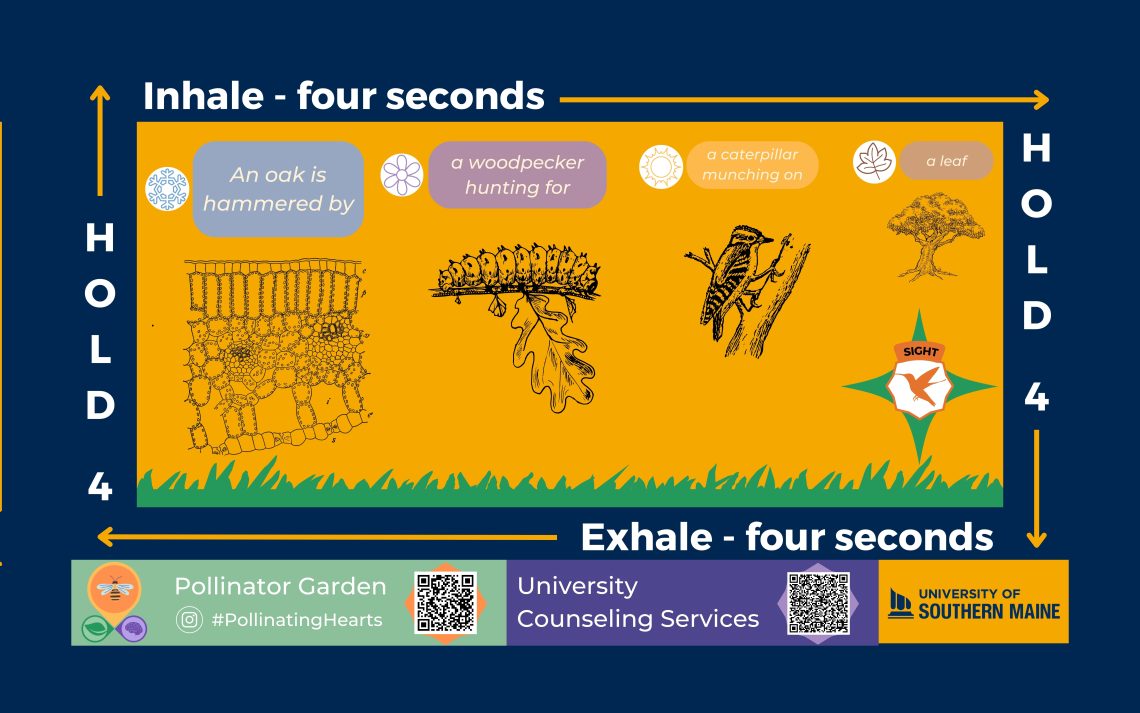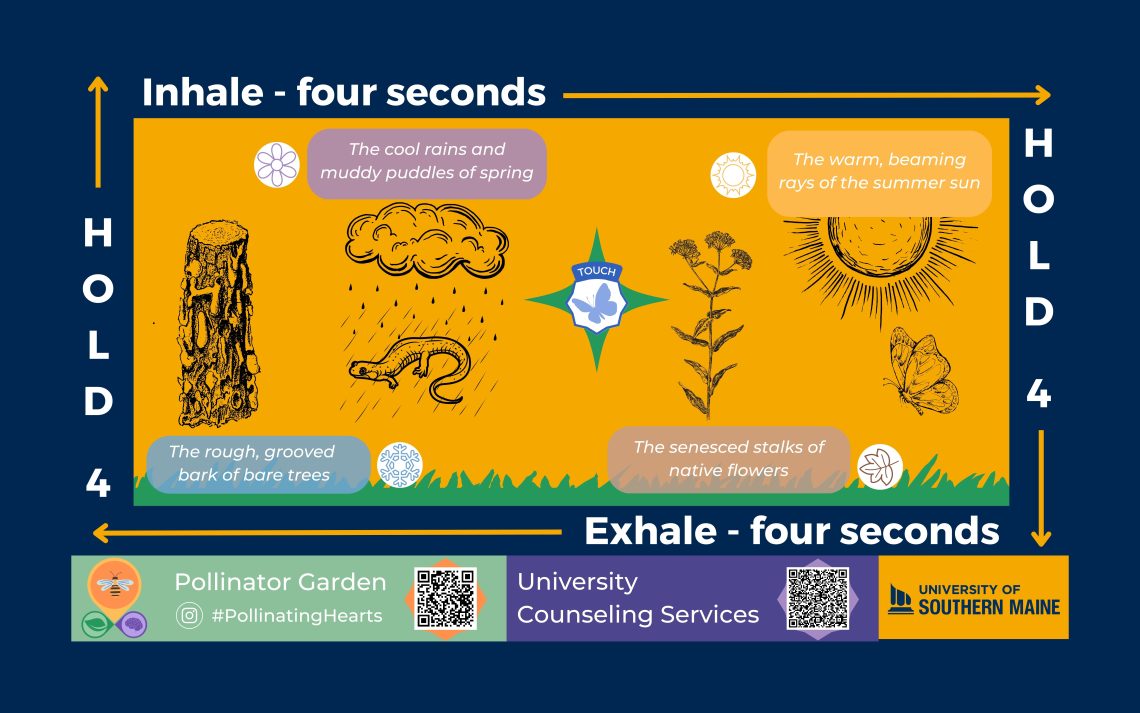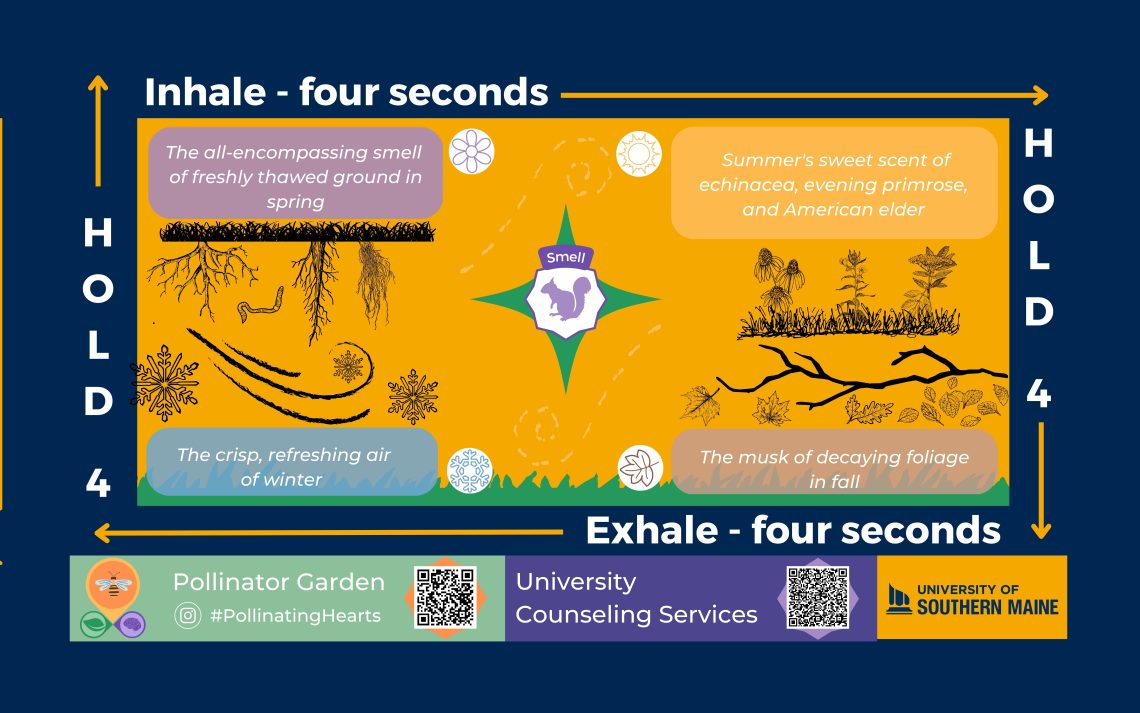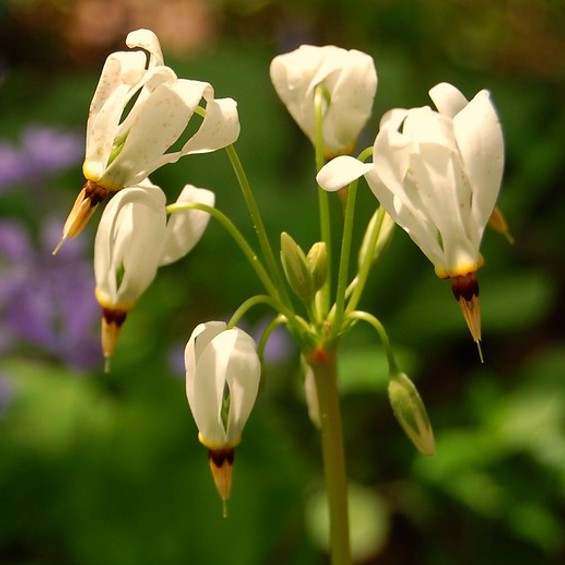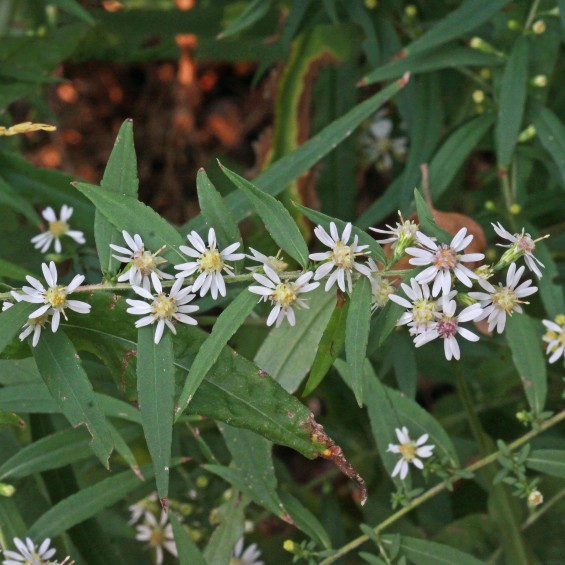The Portland campus is on the ancestral homelands of the Abenaki peoples, and a major purpose of this project is to return native plants to this landscape. To explore the native plants featured in the garden, orient yourself to which sign you are standing nearest. Each sign is based on a sense, including sight, smell, touch and sound. Scroll down to discover which plants are growing near each sign.
Many of the plants featured here have important edible, medicinal, or spiritual significance for the Abenaki, Wabanaki, and many other people. Given that the purpose of this garden is restore native plant habitat, we ask that you don’t pick these plants or their seeds, so that they can become better established in this space and someday become more prevalent in the wild. There are, however, plenty of non-native cherry, apple, and strawberry cultivars in the garden that may be picked when ripe for personal use at your own risk. The University of Southern Maine is not liable for anyone’s use of these plants.
Sight
Common names: Blue Iris, Northern Blue Flag, Harlequin Blue Flag
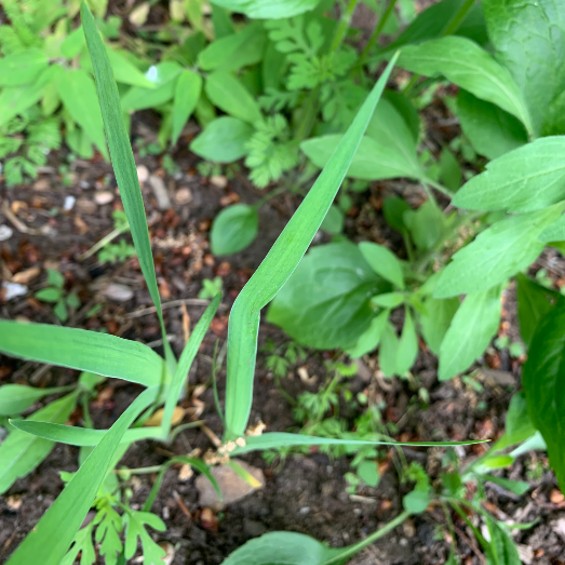
Description: A hardy native perennial that blooms in early summer. These eye-gems can be found growing in water or along the banks of a pond, stream or river.
ID: Patches of showy, narrow-petaled violet flowers. Leaves are also narrow and between 4-31 inches long.
Flowering time: Late spring to early summer
Wildlife dependents: Bumblebees, large carpenter bees, sometimes flies, and moths.
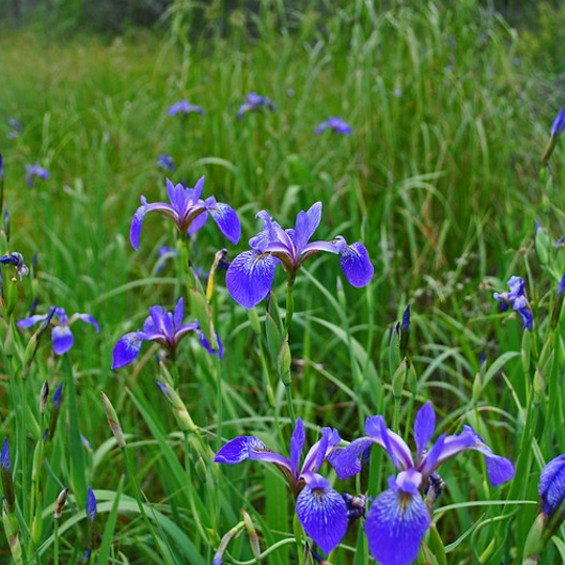
Grow your own: Grows best in full sun in rich soil. In hot temperatures, part sun is also a good spot.
Interesting facts: The history of the iris name can be traced back to Ancient Greece and the Goddess, Iris.
Citation: “Plant Database.” Lady Bird Johnson Wildflower Center– The University of Texas at Austin.
Common name: Sundial lupine, Wild Lupine, Old Maid’s Bonnet
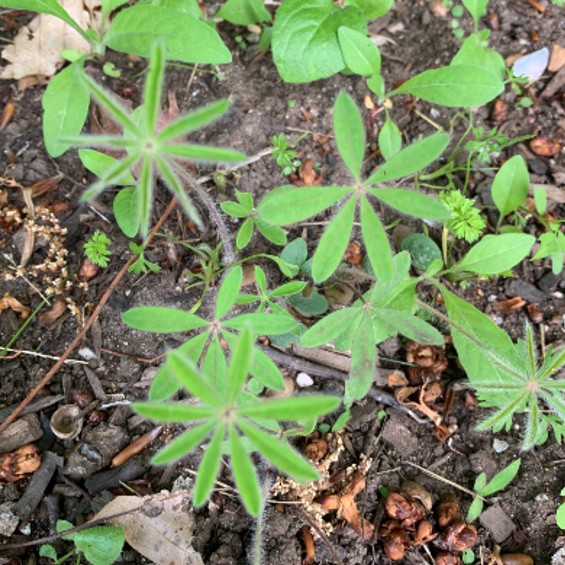
Description: A sensitive native plant that is far more rare than its bigger cousins, who have more numerous leaflets. For the past two decades, native lupine populations have become nearly extinct in the northeast due to drought, decreased snowpack, loss of habitat and increasing temperatures.
ID: Erect, upright stems that bloom a flamboyant range of blue-to-pink colored pea-like flowers with palmately divided leaves. Each leaf has 7-11 leaflets, compared to the non-native variety that has 11-17.
Flowering time: May – June
Wildlife dependents: Honeybees, mason bees, bumblebees, hummingbirds, and the endangered Karner Blue butterfly.
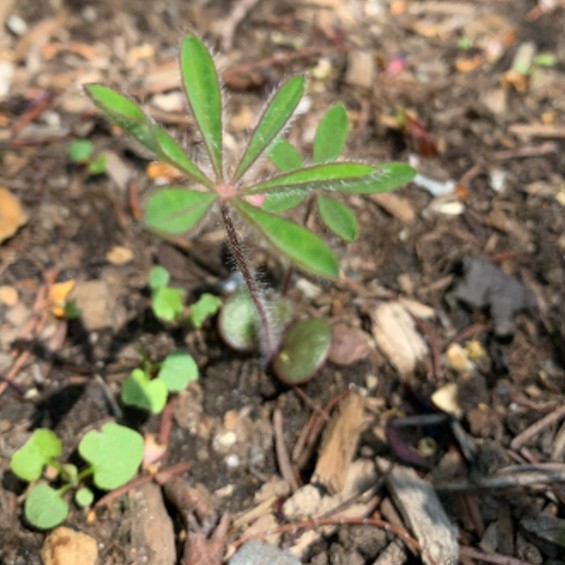
Grow your own: Does best in dry, sandy soils with abundant sunlight. Does not tolerate competition when young.
Interesting facts: Gets its name from Wolf lupus because it was once believed that lupine “wolfs up” all the minerals from the soil, however the plant has been found to enhance soil fertility.
Citations: “Plant Database.” Lady Bird Johnson Wildflower Center– The University of Texas at Austin.
“Maine Natural Areas Program.” ME Dept. of Agriculture, Conservation & Forestry.
“Lupinus perennis.” Go Botany– Native Plant Trust.
Common names: Bee Balm, Wild Bergamot, Eastern Bergamot
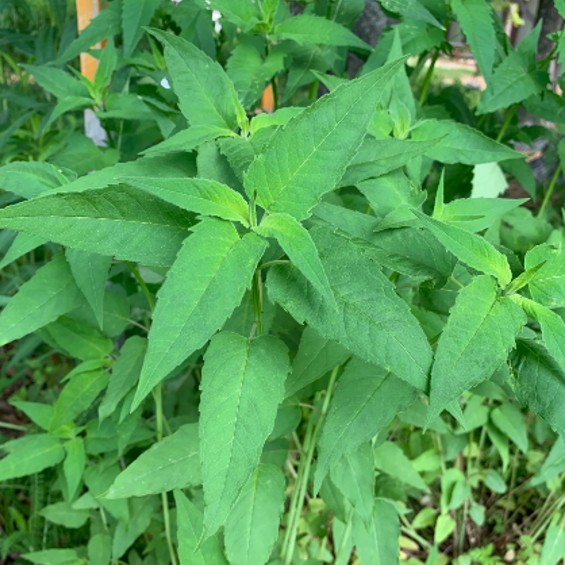
Description: A native perennial usually found in dry soils, but sometimes in wetlands.
ID: Pinkish, lavender blooms on top of a square stem. Circular flower heads are no more than a few inches in width, and the plant can grow up to 3-4 feet tall.
Flowering time: Mid summer to early fall
Wildlife dependents: Bees, such as Bumble bees, Cuckoos, and Sweats. Butterflies, such as the Eastern Tiger and Monarch. Moths and hummingbirds also rely on this plant.
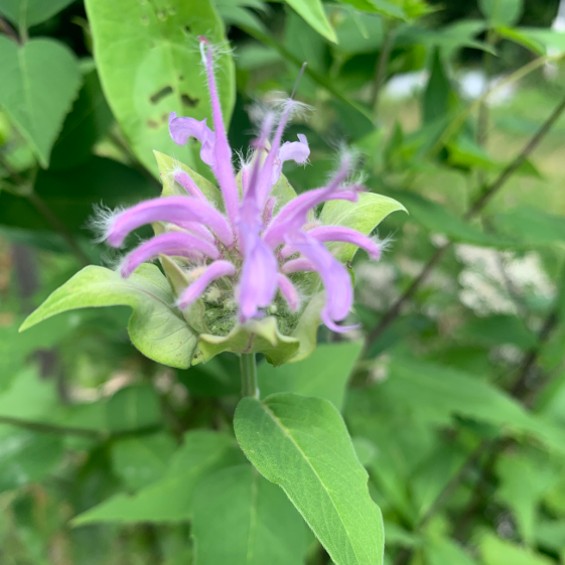
Grow your own: Plant seeds in the fall in full sun to part sun. One challenge to growing bee balm is powdery mildew when the grow area lacks aeration. An organic solution to this is a neem-based fungicide, but use caution because it can be harmful to honeybees when not used properly. An alternative is a milk or baking soda solution made with a tablespoon of baking soda and ½ teaspoon of castile soap.
Interesting facts: It smells like oregano to many people.
Citations: “Monarda fistulosa– wild bee-balm- wild bergamot.” Go Botany- Native Plant Trust.
“Wild Bergamot- Monarda fistulosa.” Pollinators of Native Plants. By Heather Holm. 2014. Pollination Press, LLC. Minnetonka, MN.
Common names: Culver’s Root, Bowman’s Root
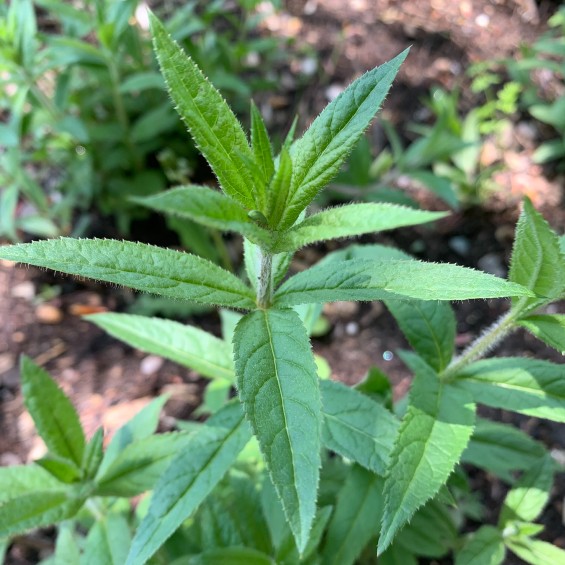
Description: Native perennial found in open woods, thickets, and moist meadows.
ID: Known for its long-spiked flower, this plant can reach as high as seven feet in the right conditions. The stems are hairy, as well as the leaves to a lesser extent. Its tiny flowers are usually some shade of pink or white.
Flowering time: June- September
Wildlife dependents: Wasps, such as the Great Golden Digger. Bees, including the leafcutter and long-horned. Butterflies and moths also frequent this plant.
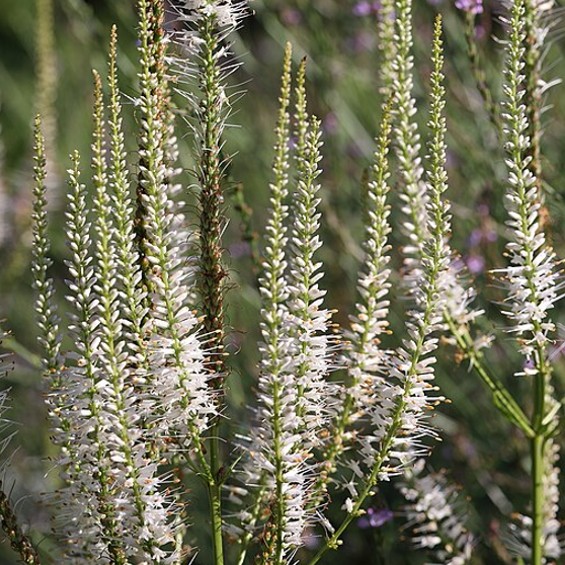
Grow your own: Plant in full sun in well-drained, but rich soil.
Interesting facts: It’s common name, Culver’s Root comes from the name of a doctor from the 18th century who used it for medicinal purposes.
Citations: “Plant Database.” Lady Bird Johnson Wildflower Center – The University of Texas at Austin.
Veronicastrum virginicum- Culver’s Root.” Pollinators of Native Plants. By Heather Holm. 2014. Pollination Press, LLC. Minnetonka, MN.
Common name: Swamp Milkweed, Rose Milkweed, Rose Milkflower, Swamp Silkweed
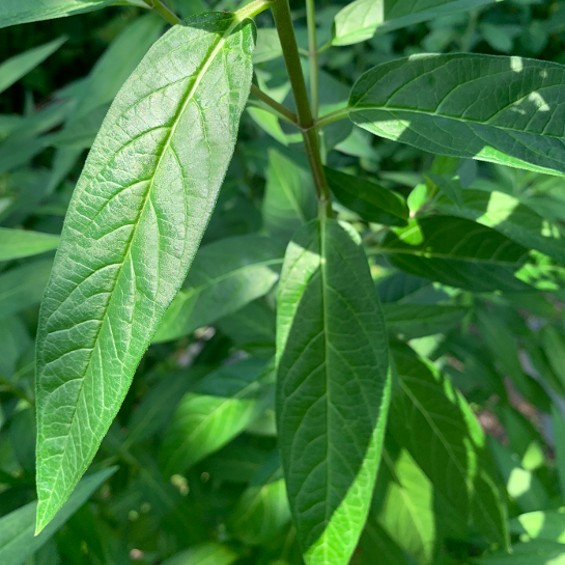
Description: A showy, native-to-Maine milkweed.
ID: Typically grows 3-4 feet tall on branching stems, and has a long tap root. It blooms tight clusters of small fragrant, vanilla-scented, pink-to-mauve flowers with 5 reflexed petals and an elevated central crown.
Flowering time: June to August
Wildlife dependents: flies, beetles, ants, bees, wasps, and butterflies, including the endangered Monarch
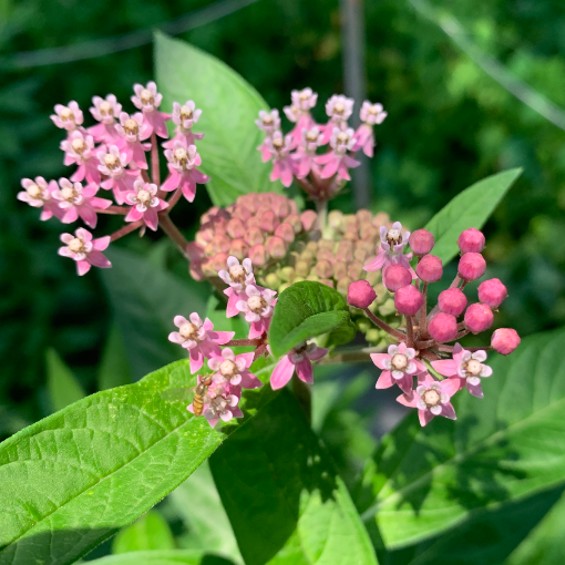
Grow your own: this loves full sun and moist to medium soil.
Interesting facts: sometimes the plant’s leaves turn inward and upward resembling the prow of a ship
Citations: “Plant Database.” Lady Bird Johnson Wildflower Center – The University of Texas at Austin
“Swamp Milkweed (Asclepias incarnata L.)”. Plant of the Week. U.S. Forest Service.
Common name: Black Bugbane, Black Cohosh, Black Snakeroot, Fairy Candles
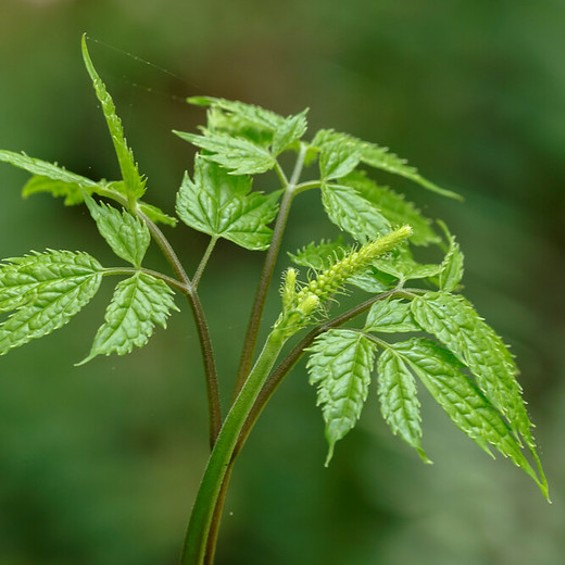
Description: A native perennial that blooms in summer when many woodland flowers have passed, adding a striking pop of color to the forest floor.
ID: The flowers, on a long raceme, look like beautiful white wands. Compound leaves with numerous serrated leaflets.
Flowering time: As early as June or as late as August
Wildlife dependents: bees, flies, beetles, and butterflies, such as the Appalachian Azure.
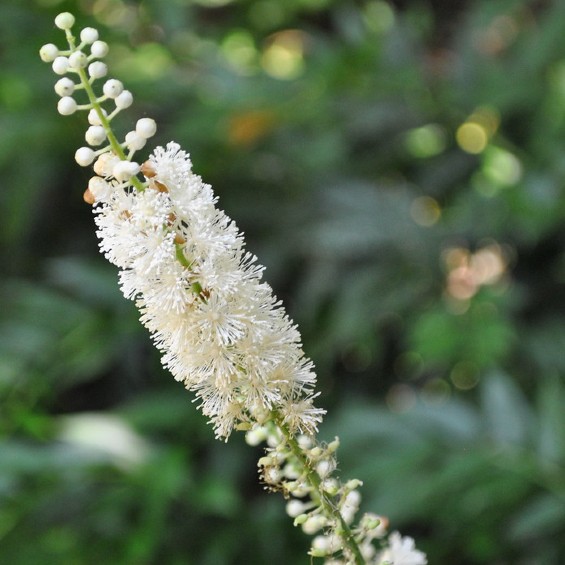
Grow your own: Is tricky to grow from seed, but does best in medium moisture, shady or partly shady conditions. Prefers rich soils.
Interesting facts: Black Cohosh is endangered in Massachusetts.
Citation: “Actaea racemosa var racemosa.” Lady Bird Johnson Wildflower Center – The University of Texas at Austin.
“Black Cohosh.” Natural Heritage & Endangered Species Program. Massachusetts Division of Fisheries and Wildlife.
Common name: Purple Prairie Clover, Violet Prairie Clover, Red Tassel Flower, Thimbleweed,
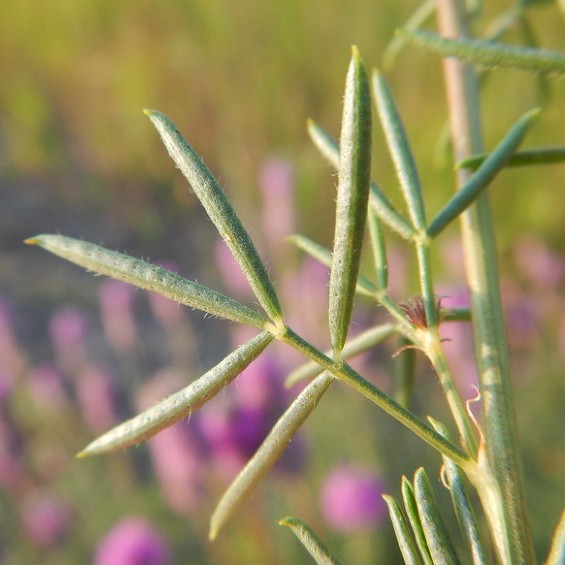
Description: A species of flowering plant in the legume family known as purple prairie clover. It’s native to most of the midwest and as far east as New York.
ID: Grows up to 1-3 feet tall and sports tiny purple flowers in dense, cone-like heads.
Flowering time: Late summer.
Wildlife dependents: bees, butterflies, wasps, and skippers.
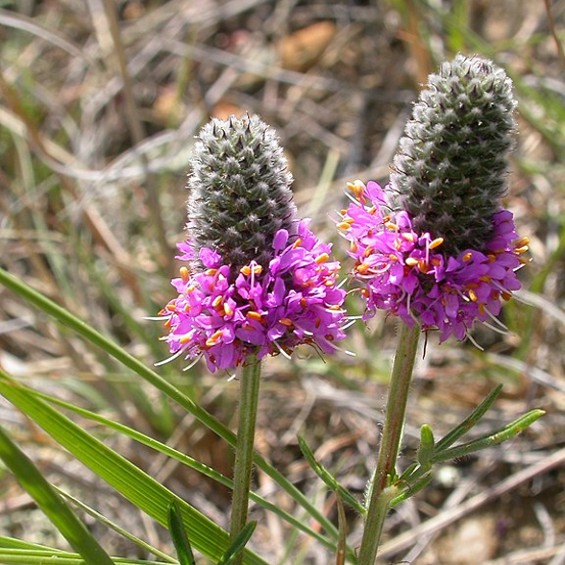
Grow your own: Plant in full sun in dry to moist soils.
Interesting facts: The Purple Prairie clover is sometimes planted after strip mining occurs in an effort to rehabilitate the land.
Citation: “Plant Database.” Lady Bird Johnson Wildflower Center – The University of Texas at Austin,
“Dalea purpurea.” North Carolina Extension Gardener Toolbox.
Common name: Blue-eyed grass, Bermuda blue-eyed grass, Blue Eyes, Grass Flower, Sassy Grass
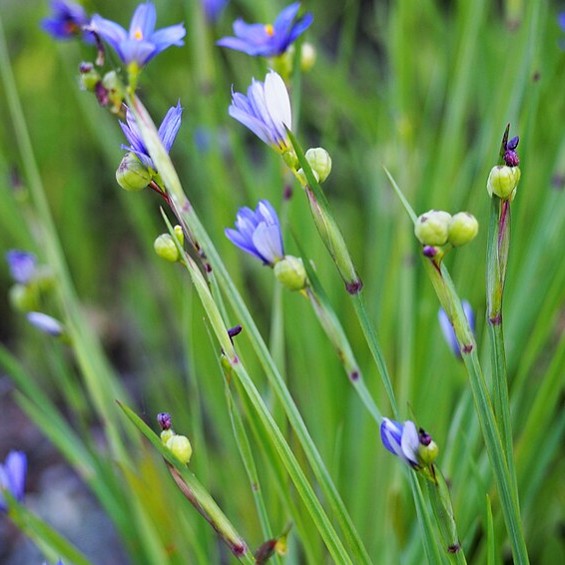
Description: A small, native perennial with rhizomes.
ID: This branching plant can easily be mistaken for the grass in your lawn, until it suddenly dazzles with its blue to violet flowers.
Flowering time: Spring to summer
Wildlife dependents: Bees, pollinators, prairie chickens and wild turkeys.
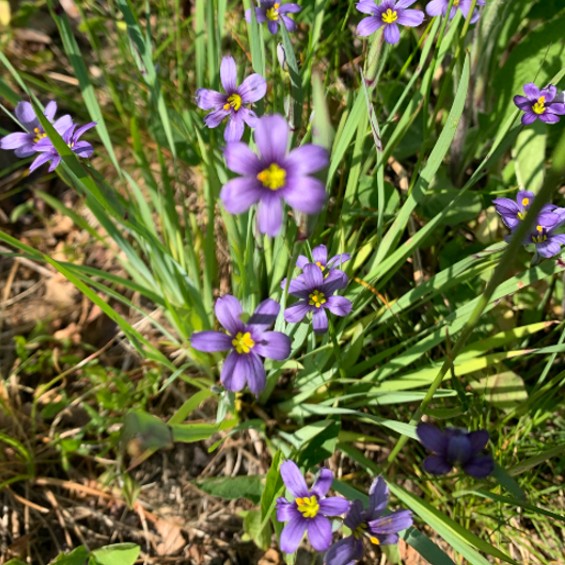
Grow your own: Plant in full sun to part shade in medium moisture, well-drained soils.
Interesting facts: It looks like a mini Iris because its in the Iris family.
Citation: “Sisyrinchium angustifolium.” Lady Bird Johnson Wildflower Center – The University of Texas at Austin.
Common names: Red Columbine, Wild Columbine, American Columbine, Meetinghouses, Rock-bells, Rock-lily, Jack-in-trousers
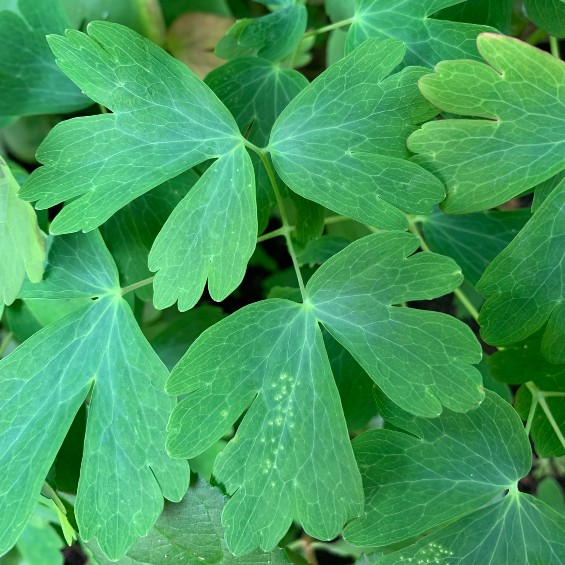
Description: A native early-blooming wildflower.
ID: Prominent 1 ½ inch red and yellow flowers hang upside down the stem, and resemble tiny ballerinas. The foliage can appear bushy and ruffled like a Tom turkey, while the stems leading to the flowers are long and thin.
Flowering time: Spring to early summer.
Wildlife dependents: hummingbirds, bees, and several butterflies and moths, including ones that share its namesake such as the Columbine Duskywing Butterfly and the Columbine Borer Moth.
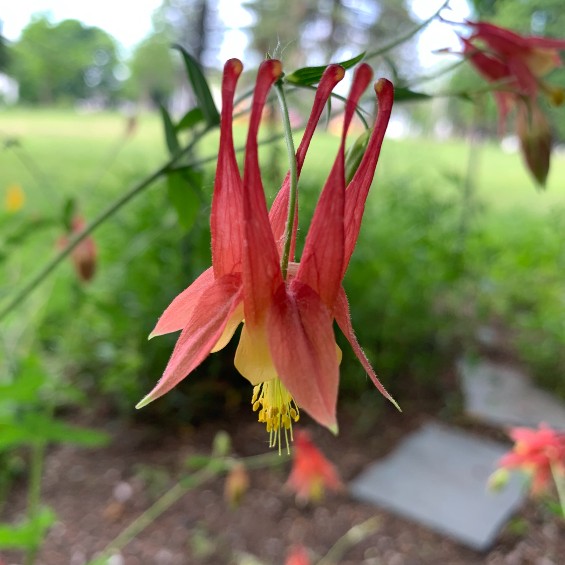
Grow your own: Prefers part shade but will tolerate full sun to partial shade. In our experience, it can survive fairly dry conditions.
Interesting facts: Belongs to the buttercup family, which can be seen in the shape and vein pattern of the leaves.
Citations: “Aquilegia canadensis.” Lady Bird Johnson Wildflower Center – The University of Texas at Austin.
“Wild Columbine- Aquilegia canadensis” Pollinators of Native Plants. By Heather Holm. 2014. Pollination Press, LLC. Minnetonka, MN.
Common names: Bottle Gentian, Closed Gentian, or Closed Bottle Gentian
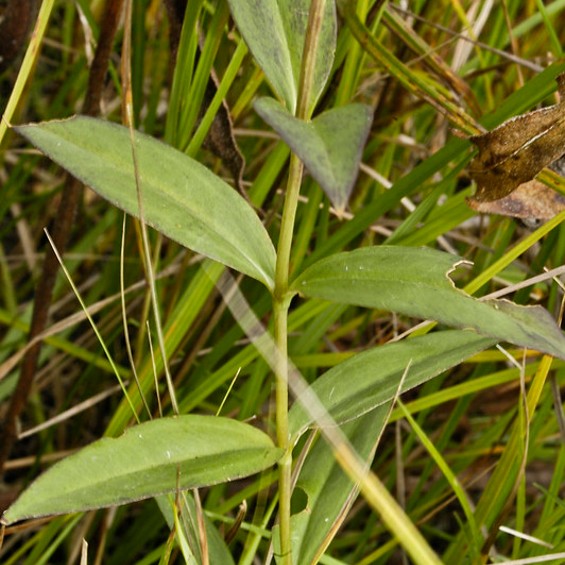
Description: A native species known for its “bottled-up” flowers.
ID: Has bottle-like deep blue flowers, purple or whitish flowers. The leaves are opposite on the stem.
Flowering time: August – October.
Wildlife dependents: Primarily bumblebees.
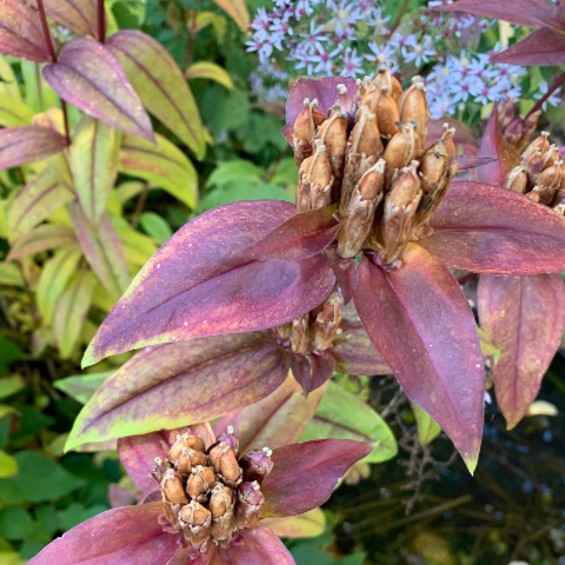
Grow your own: This is a difficult plant to grow from seed, it grows slows, and it can be challengin to source. Plant in moist or wet meadow conditions.
Interesting facts: The flowers never open, so pollinators have to squeeze in. Bumblebees have the strength to do it, whereas most other insects do not.
Citations: “Gentiana andrewsii.” Lady Bird Johnson Wildflower Center – The University of Texas at Austin.
“Gentiana andrewsii- Andrew’s Bottle Gentian.” Go Botany. Native Plant Trust.
“Bottle Gentian- Gentiana andrewsii.” Pollinators of Native Plants. By Heather Holm. 2014. Pollination Press, LLC. Minnetonka, MN.
Touch
Common names: Canada Goldenrod
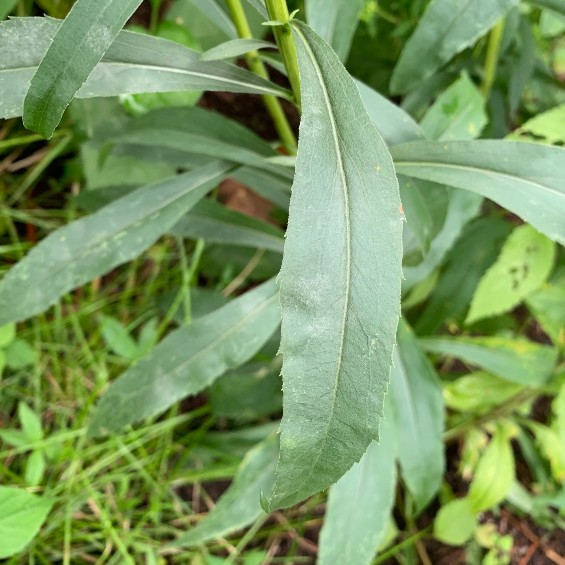
Description: A strong, native species.
ID: Growing up to 6 feet tall on sturdy stems, this plants flowers can often make an entire field seem like a sea of yellow during flowering season.
Flowering time: August – October.
Wildlife dependents: Canada Goldenrod is considered a “keystone” species, meaning that it is a significant source of food and habitat for the local ecosystem. Over 100 different insects are known to utilize this plant, including bees and butterflies.
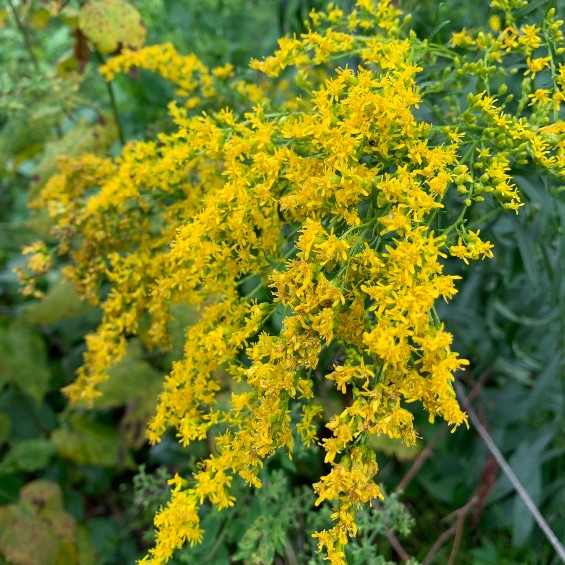
Grow your own: Thrives in full sun and well-drained soils. Tolerates light shade but will not tolerate full shade. Be cautious where you plant this, as it is aggressive and can take over weaker species. This trait can be useful as a border at the edge of a plot where invasive species may migrate in.
Interesting facts: Many people erroneously blame this innocent plant for “hay-fever,” because it is in full bloom when peoples’ allergies are high. Its pollen is not wind-borne, as it is pollinated by insects. Meanwhile, ragweed is the silent culprit, hiding with its bland dull-green flowers. Ragweed is wind pollinated and sheds its pollen prolifically during allergy season.
Citations: “Solidago canadensis.” Lady Bird Johnson Wildflower Center – The University of Texas at Austin.
Nature’s Best Hope: A New Approach to Conservation that Starts in Your Yard by Doug Tallamy. 2019. Timber Press, Inc. Portland, OR.
Common name: Black Chokeberry
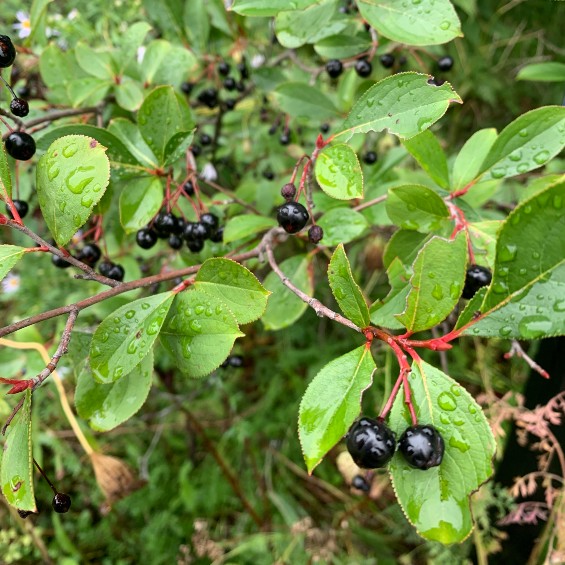
Description: Open, upright, spreading, somewhat rounded but leggy, suckering, native, deciduous shrub.
ID: Contains five-petaled flowers. The leaves are glabrous to glossy and elliptic to obovate shaped. They are dark green a couple of inches long with finely toothed margins. The berries are reminiscent of both blueberries and buckthorn berries.
Flowering time: May through June.
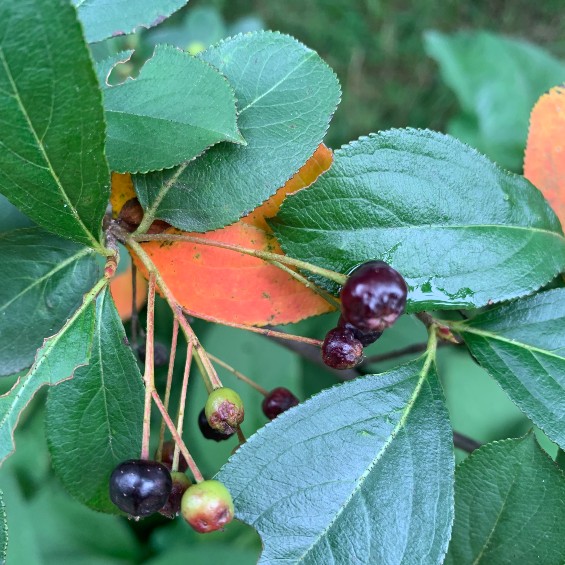
Wildlife dependents: White-tailed deer, rabbits, ruffed grouse and prairie chickens.
Grow your own: Plant in full sun or part shade in well-drained soils.
Interesting facts: The berries are sometimes used as a dye.
Citation: “Aronia melanocarpa- black chokeberry.” Go Botany. Native Plant Trust.
Common names: Wild Strawberry, Alpine Strawberry, Virginia Strawberry
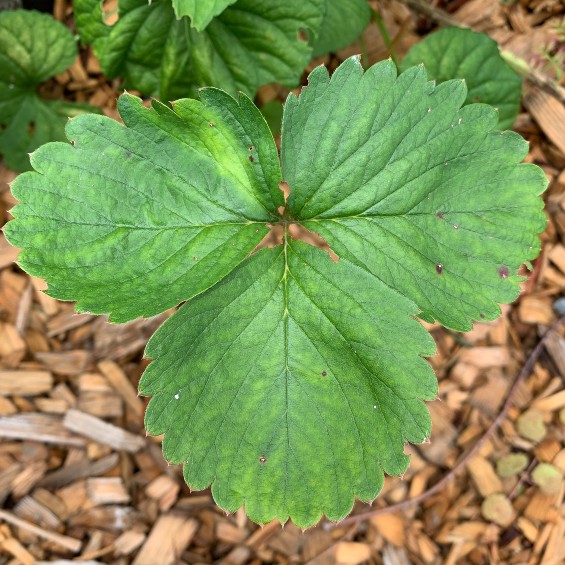
Description: A perennial ground cover plant in the rose family with some native-to-Maine varieties, such as Fragaria vesca and virginiana.
ID: Hairy flower stalk, small white flowers and red fruit.
Flowering time: Late spring throughout summer.
Wildlife dependents: Black bear, opossum, squirrel, chipmunk, turtles.
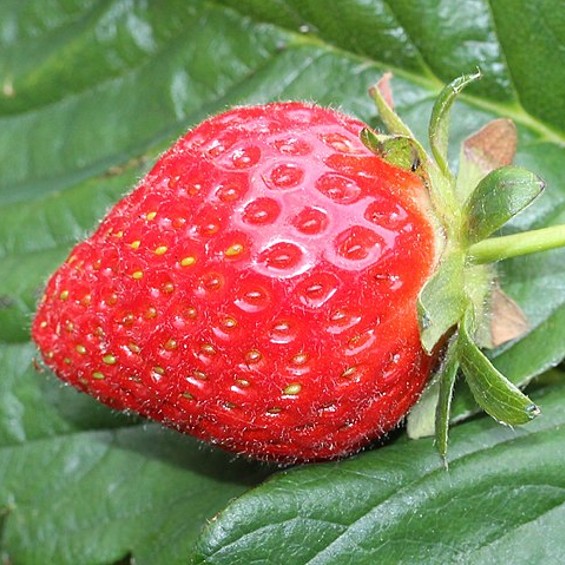
Grow your own: Plan in well-drained soil in a sunny area. Considering mulching to protect the plants through winter.
Interesting facts: Strawberries are one of the first fruits to show up during the growing season in Maine.
Citation: “Plant Database.” Lady Bird Johnson Wildflower Center – The University of Texas at Austin.
Common names: Common Evening Primrose
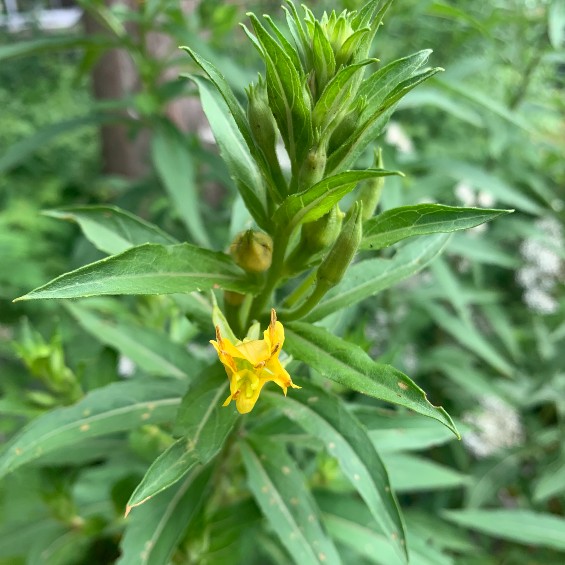
Description: A hardy native biennial that is adept at growing in marginal areas where few other native species can compete.
ID: Yellow flowers, atop of a bristly hairy central stem. The stem is strong and can feel almost woody by the end of the growing season. Leaves are narrow and lance shaped. The flowers are never all in bloom at the same time. Rather, just a few come out together.
Flowering time: Mid summer through mid fall
Wildlife dependents: Deer, birds, and moths.
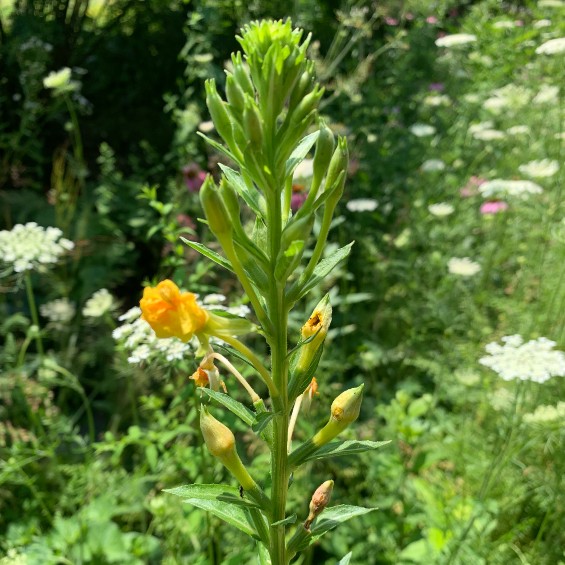
Grow your own: Seeds are easy to come by in the fall if wild harvested, since this plant is so prolific. It likes sun, but does okay in part shade. It tolerates a range of moistures from pretty dry to pretty wet.
Interesting facts: The common name, Evening Primrose, hints at the fact that the flowers bloom in the evening, and usually close up by late morning of the following day.
Citations: “Oenothera biennis- Common Evening-primrose.” Go Botany. Native Plant Trust.
“Oenothera biennis.” Lady Bird Johnson Wildlife Center.
Smell
Common name: Common Milkweed, Butterfly Flower, Silkweed, Silky Swallow-wort
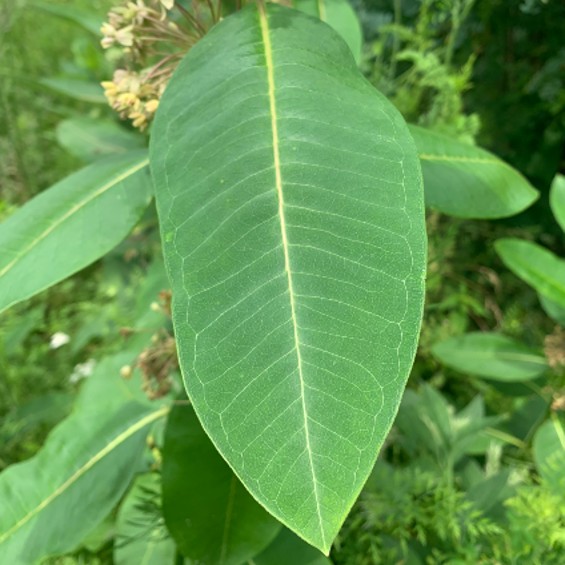
Description: A native perennial found in fields, open woods, waste areas, roadsides and along railroad tracks. It also pops up as a weed in many gardens, but don’t mistake this plant simply for a weed. This is a potent attractor for pollinators.
ID: It typically grows 3-4 feet on stout, upright stems with thick, broad-oblong, reddish-veined, light-green leaves. It blooms domed, slightly drooping clusters of vanilla-scented, pinkish-purple flowers.
Flowering time: June to August
Wildlife dependents: Flies, beetles, ants, bees, wasps, butterflies, and moths, including the swallowtail butterfly and, of course, the infamous monarch.
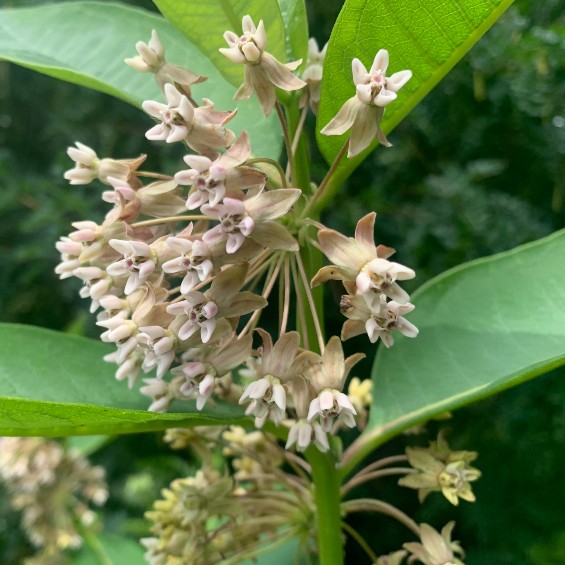
Grow your own: Common milkweed is the easiest milkweed to plant in our experience. It likes full sun, but can tolerate a little bit of shade. Once established, it tends to spread through underground runners. So, if you plant one, be prepared for multiple shoots the following year.
Interesting facts:
Citation: “Asclepias syriaca- Common Milkweed.” Lady Bird Johnson Wildflower Center – The University of Texas at Austin.
Common names: Joe Pye-weed, Boneset, Thoroughwort, Snakeroot
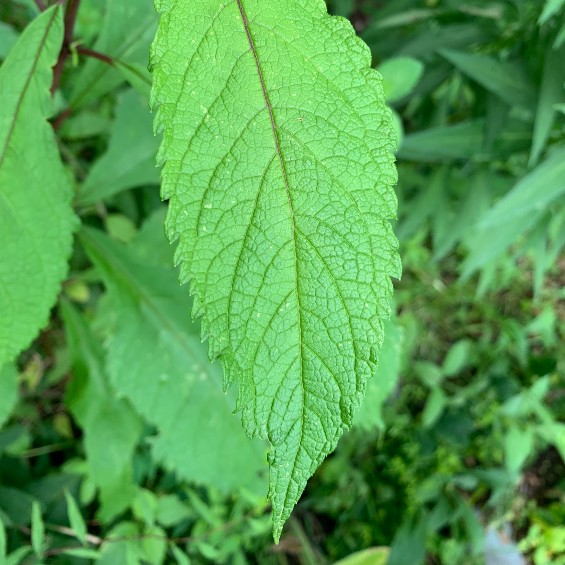
Description: A tall, native perennial found in low moist soil, wooded slopes, wet meadows, and stream margins.
ID: Typically grows 4- 7 feet tall featuring coarsely-serrated, lance-shaped, dark green leaves with whorls of 3-4 on sturdy green stems with purplish leaf nodes. Vanilla-scented, tiny, dull pinkish-purple flowers rise up from the top of the plant.
Flowering time: Mid-summer to early fall
Wildlife dependents: Long and short-tongued bees, wasps, flies, butterflies, skippers, moths, beetles.
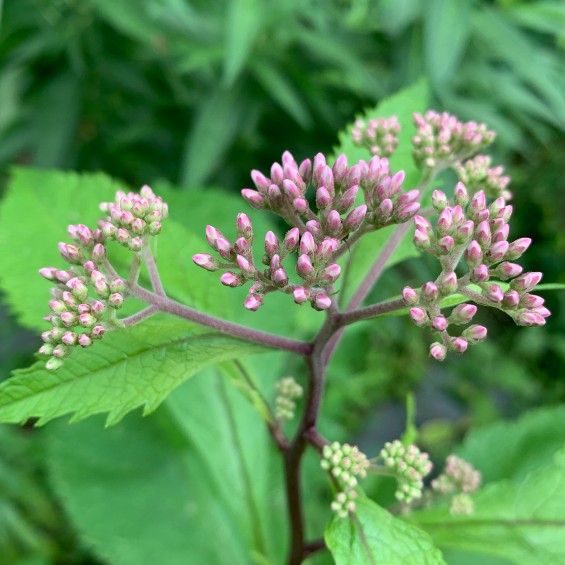
Grow your own: Thrives in full sun or partial shade but too much shade can create legginness, meaning the stem can get too tall and weak and then flop over.
Interesting facts: There are a number of legends about the origin of the common name, “Joe Pyeweed.” Most revolve around a man known as Joe Pye who used the plant for medicinal purposes with his patients. Historical citations are conflicting on whether he was Abenaki, Wampanoag, Mohican, or a member of another Native nation. Pearce & Pringle posit that the most likely person behind the legend is Joseph Shauquethqueat, a Mohican sachem who lived in western Massachusetts around 1818.
Citations: “Joe Pye, Joe Pye’s Law, and Joe-Pye-Weed: The History and Eponymy of the Common Name Joe-Pye-Weed for Eutrochium Species (Asteraceae).” by Richard B. Pearce and James S. Pringle. The Great Lakes Botanist. 2017. P. 177.
“Eutrochium purpureum.” Lady Bird Johnson Wildflower Center – The University of Texas at Austin.
Common names: Hoary Vervain, Hoary Verbena, Tall Vervain, Wooly Verbena
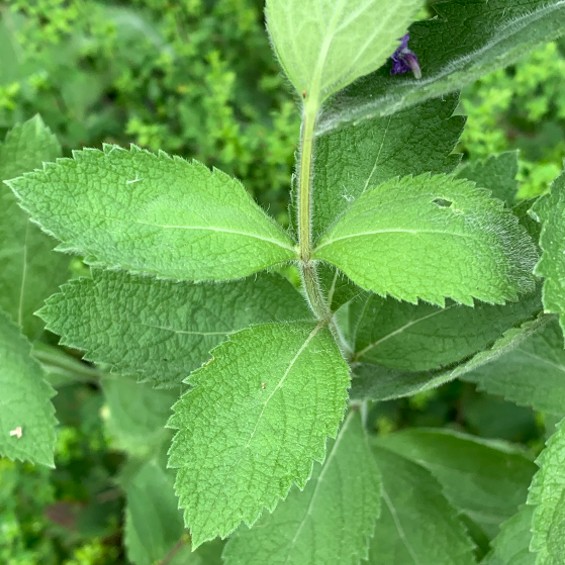
Description: A vigorous, clump-forming perennial. Contains a very important source of nectar for pollinators.
ID: Pink or blue flowers bloom from its narrow spikes. The leaves are erratically serrated, and the whole plant is covered in fine white hairs.
Flowering time: July through September
Wildlife dependents: Bees, such as Cuckoo bees, flies, such as Syrphids, beetles, and butterflies, including the common buckeye butterfly and Peck’s Skipper, among others.
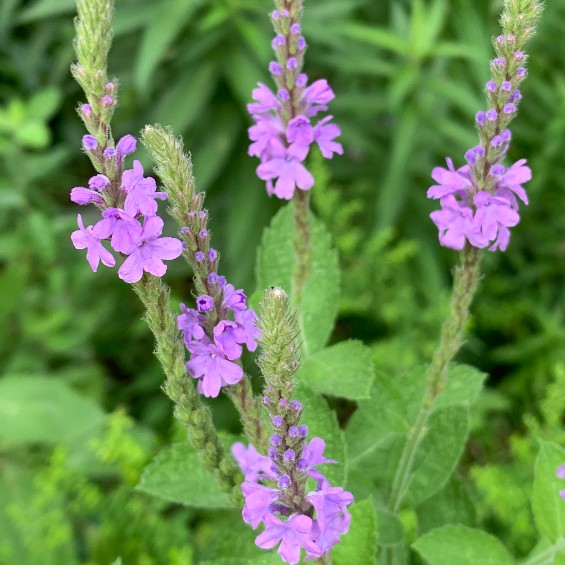
Grow your own: Dry to medium soils
Interesting facts: Hoary Vervain gets its common name from white pubescence on its gray-green leaves and stems.
Citation: “Verbena Stricta (Hoary Vervain).” Lady Bird Johnson Wildflower Center – The University of Texas at Austin.
“Hoary Vervain- Verbena stricta.” Pollinators of Native Plants. By Heather Holm. 2014. Pollination Press, LLC. Minnetonka, MN.
Common name: New York Ironweed, Vein-leaf Hawkweed
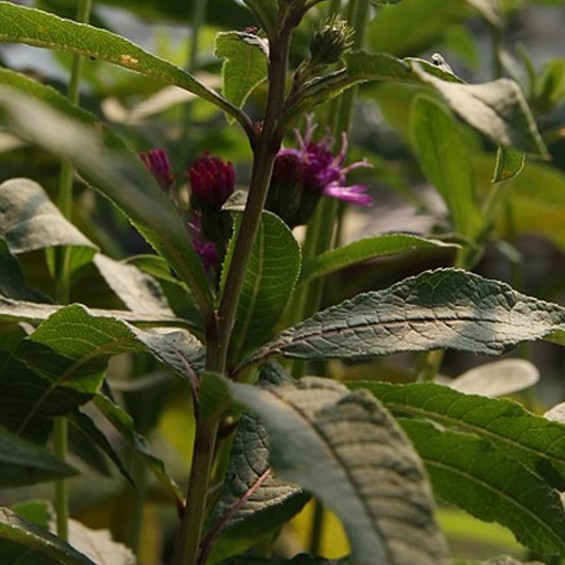
Description: A tall and strong, herbaceous, native perennial wildflower of the Aster family.
ID: It shows off fluffy, deep purple disc flowers that grow in clusters. You will often find it near ponds or in meadows.
Flowering time: Late July to September.
Wildlife dependents: Butterflies, bees, flies and beetles.
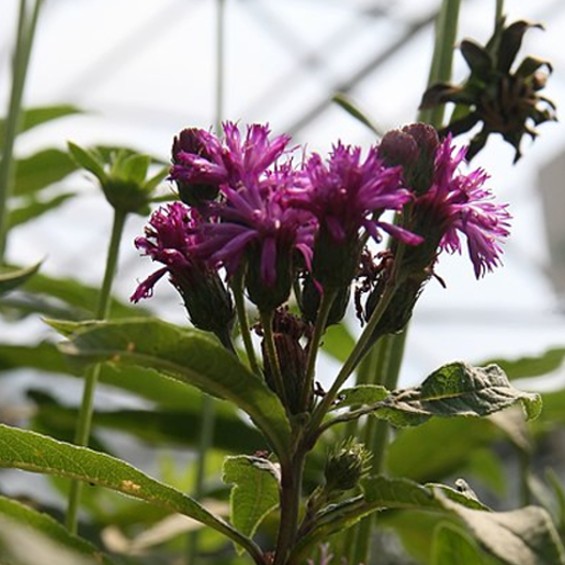
Grow your own: direct sow from seed in full sun to partial shade in the fall and overwinter
Interesting facts: It’s named Ironweed for its strong upright stalk.
Citation: “Vernonia noveboracensis.” Lady Bird Johnson Wildflower Center – The University of Texas at Austin.
Common name: Butterfly Weed, Canada Root, Fluxroot, Pleurisy Root, Orange Milkweed
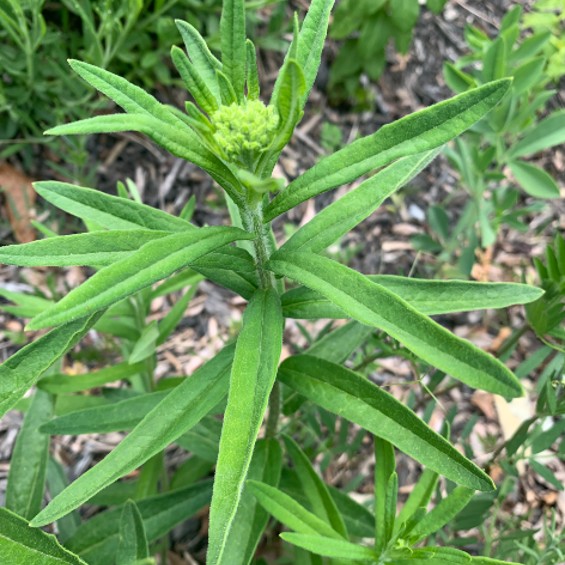
Description: Tuberous-rooted, native milkweed perennial which grows in dry/rocky open woods, glades, prairies, fields and roadsides. Very popular host for the Monarch Butterfly, in particular. It doesn’t transplant well due to its deep taproot.
ID: Usually grows 1 – 2 ½ feet tall featuring clusters of bright orange flowers and hairy stems.
Flowering time: June to August
Wildlife dependents: Bees, hummingbirds, moths and butterflies, especially the endangered monarch butterfly.
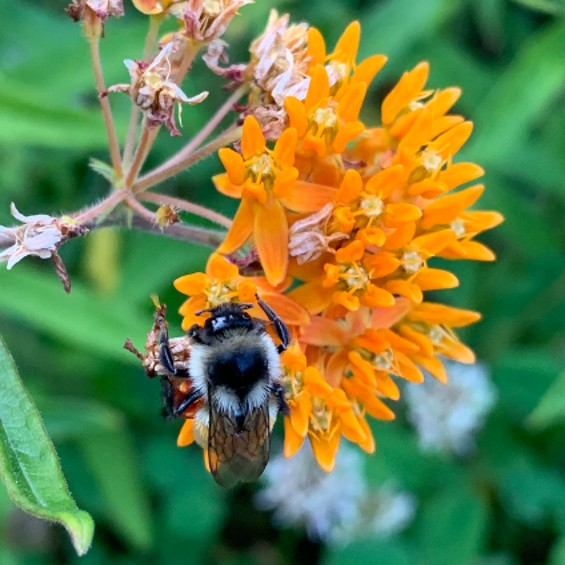
Grow your own: Plant in a sunny spot with well-drained soil. It doesn’t transplant well due to its deep taproot. In our experience, this plant has a really hard time getting established because it does not do well with competition.
Interesting facts: Butterfly weed is also known as “butterfly milkweed”, even though it produces translucent (instead of milky) sap. It can live for decades. Native populations were extirpated in Maine, meaning that they became locally extinct.
Citation: “Asclepias tuberosa.” Lady Bird Johnson Wildflower Center – The University of Texas at Austin.
Vogt, Scott. “Butterfly Weed: Fun Facts.” Dyck Arboretum, 28 June 2023.
Common names: Snowberry, Waxberry, Coralberry
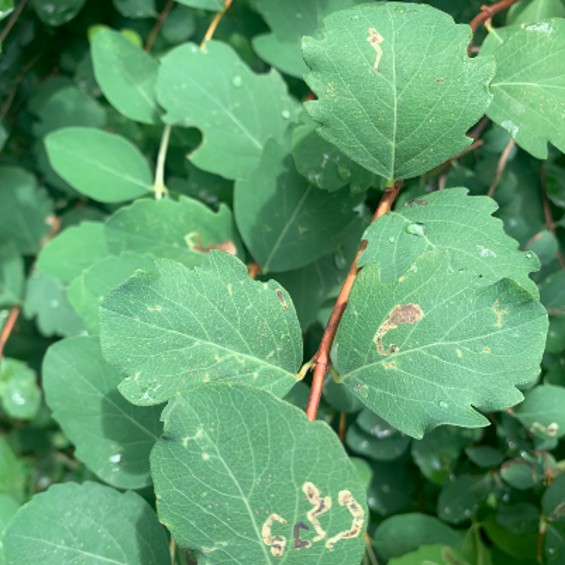
Description: Flowering bush in the honeysuckle family.
ID: Sparsely branched shrub that can grow 2 – 5 feet tall, gradually growing a thicket 4 – 6 feet wide, The slender, wiry twigs bear small, opposite leaves and inconspicuous flower clusters followed by large, snow white berry-like fruit which eventually turns brown. This hollow-stemmed shrub tiny, pinkish-white, bell-shaped flowers in small terminal or axillary clusters.
Flowering time: June, July
Wildlife dependents: Bears, songbirds, and small winged pollinators.
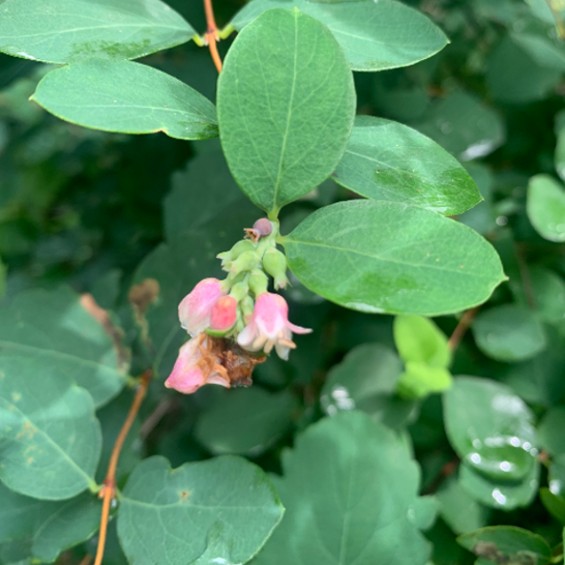
Grow your own: Plant outside in early autumn or spring. It will grow in sun or shade.
Interesting facts: Most parts of this plant are poisonous to humans. Although it is native, it can grow very aggressively, so some people mistake it for an invasive species.
Citation: “Symphoricarpos albus.” Lady Bird Johnson Wildflower Center – The University of Texas at Austin.
Common names: Black-eyed Coneflower, Black-eyed Susan
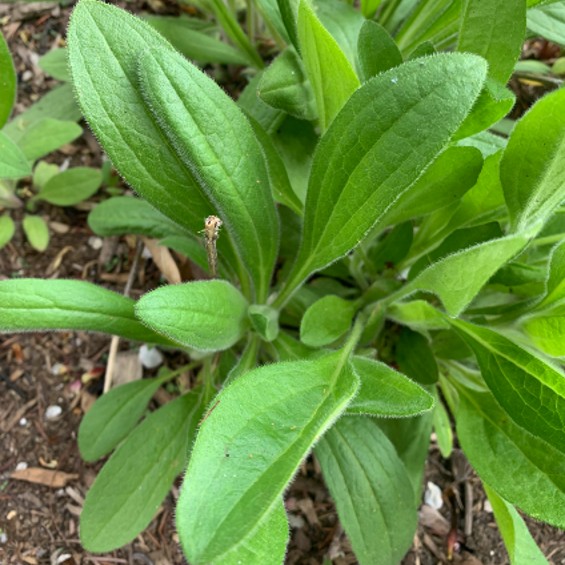
Description: This native, deer-resistant flower often blankets open fields and prairies. Depending on conditions, it may act as an annual or biennial. Birds, bees and butterflies alike enjoy this pollen-rich flower.
ID: Produces bright yellow, daisy-like flowers which have dark centers/”eyes.” Covered in short hairs.
Flowering time: June – October.
Wildlife dependents: Birds, such as Goldfinches, chickadees, cardinals, white-breasted nuthatches, sparrows. Lots of different bees, including Long-horned, Mining and Two Moons Beewolf.
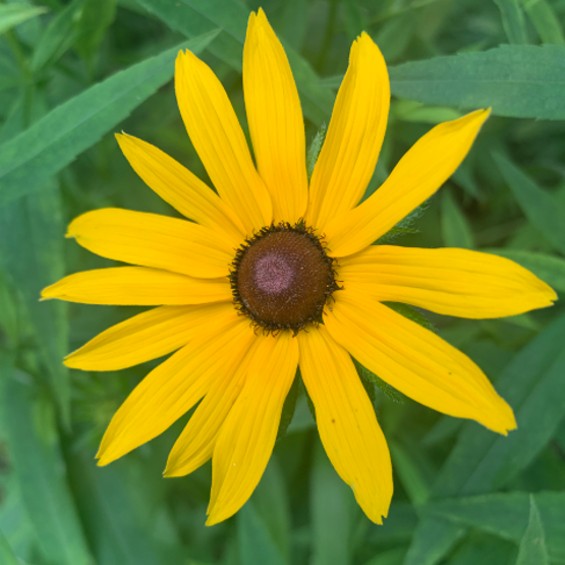
Grow your own: Plant in full sun. Unlike many native plants, these seeds don’t need a long cold cycle to break their dormancy. They can be planted in the fall or spring. In our experience, they are among the easiest native plants to grow from seed.
Interesting facts: These plants are usually the first to grow in an area ravaged by fire.
Citation: “Rudbeckia hirta.” Lady Bird Johnson Wildflower Center – The University of Texas at Austin.
“Black-eyed Susan: History & Fun Facts.” Department of Plant Pathology. Ohio State University.
“Black-eyed Susan- Rudbeckia hirta.” Pollinators of Native Plants. By Heather Holm. 2014. Pollination Press, LLC. Minnetonka, MN.
Common names: King Solomon’s Seal, Hairy Solomon’s Seal or Solomon’s Seal
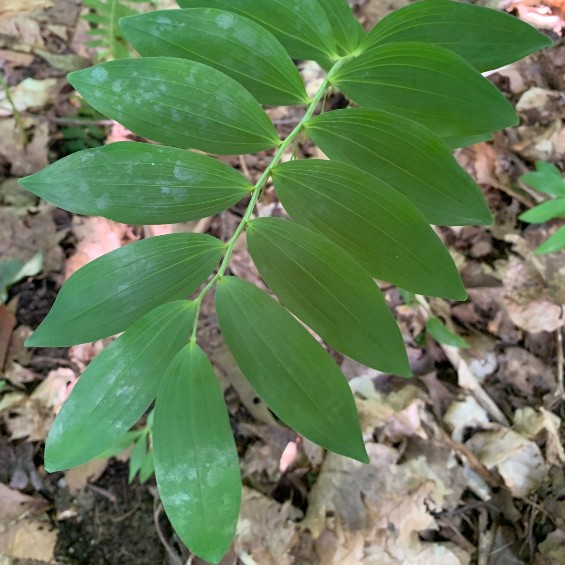
Description: Herbaceous flowering genus, with two varieties native to Maine, including Polygonatum pubescens and Polygonatum biflorum.
ID: Leaves grow on arching stalks that make a zig-zag pattern. It can grow 1 – 5 feet long, with greenish-white tubular flowers that hang down from the main stem.
Flowering time: Spring or early summer.
Wildlife dependents: Bees pollinate the flowers. Birds, rabbit and deer eat the fruit and occasionnally the leaves. Some sources claim they are deer resistant, but that has not been our personal experience, especially when the shoots are young and tender.
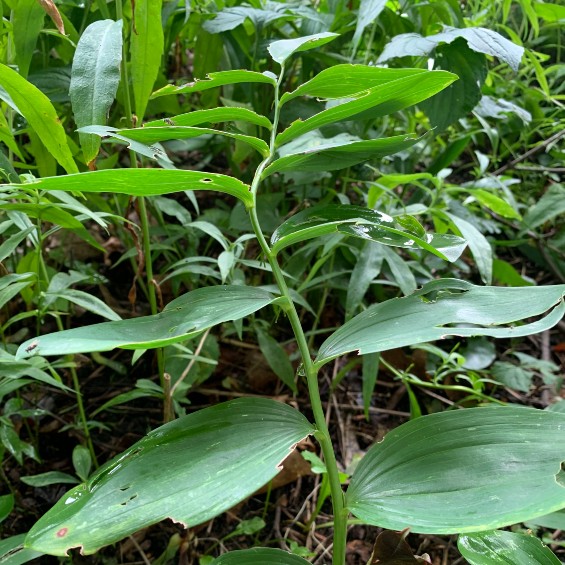
Grow your own: Plant in well-drained soils that are rich and/or contain humus. Solomon’s Seal likes shady areas.
Interesting facts: Named “Solomon’s seal” due to the scars on the rhizomes which supposedly look like the marks of an old-fashioned wax seal made by a ring, and several legends about the biblical King Solomon revolved around the magical properties of his seal.
Citation: “BWRS Featured Plant: Smooth Solomon’s Seal.” 2019 May Plant of the Month. Minnesota Board of Water and Soil Resources.
“Polygonatum biflorum.” Lady Bird Johnson Wildflower Center – The University of Texas at Austin.
“Genus: Polygonatum- Solomon’s Seal.” Go Botany. Native Plant Trust.
“Solomon’s Seal, Polygonatum spp.” Wisconsin Horticulture. Division of Extension.
Common names: Blue Stem Goldenrod, Wreath Goldenrod, Woodland Goldenrod
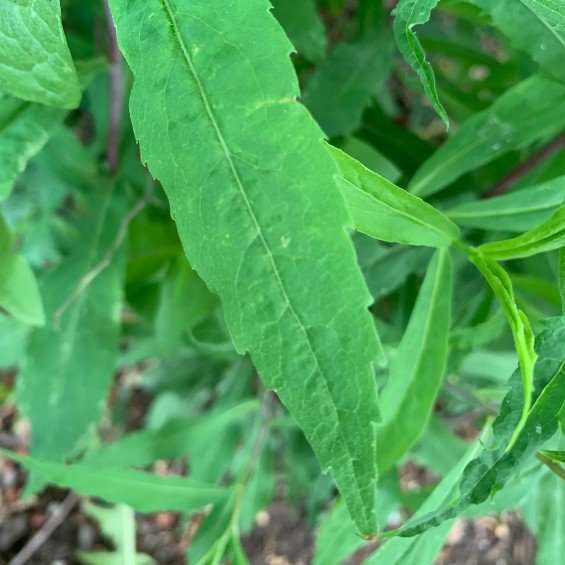
Description: A perennial native wildflower. May be found further in the forest than other, showier golden rods. It may show up in upland areas or rocky slopes.
ID: Blooms very small golden flowerheads from an arched stem that sometimes looks like it is slightly zig-zagging. The blue to purple stem makes this Solidago stand out from its relatives.
Flowering time: Late summer to early fall.
Wildlife dependents: Butterflies and birds, including the Goldfinches, grosbeaks, and nuthatches.
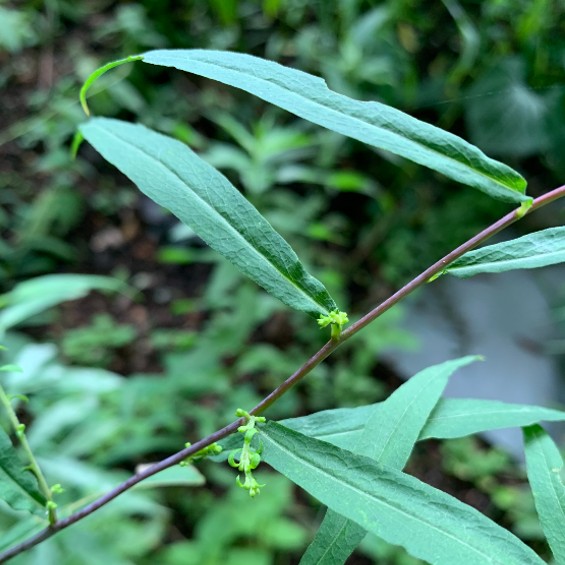
Grow your own: Plant in either full sun or part shade in well-drained soil.
Interesting facts: There are over 20 native species of goldenrods in the northeastern United States.
Citation: “Solidago caesia.” Lady Bird Johnson Wildflower Center – The University of Texas at Austin.
“Solidago- Golden Rod.” Go Botany. Native Plant Trust.
Common names: Eastern Shooting Star, American Cowslip, Roosterheads, Prairie Pointers
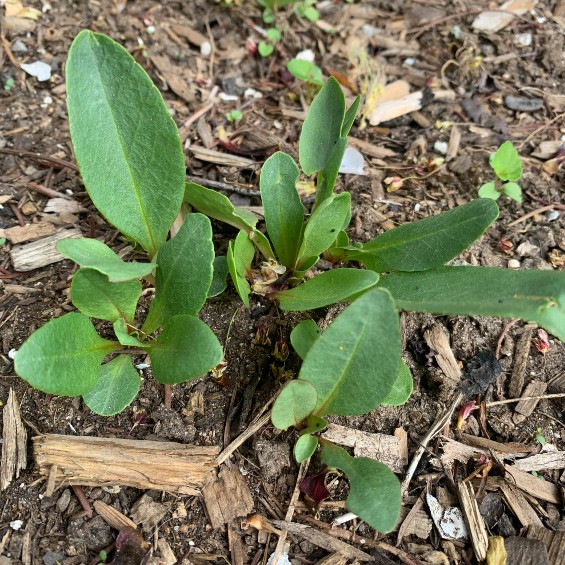
Description: A perennial native to the eastern United States, but not specifically to Maine. This member of the Primrose family grows in meadows, prairies and sometimes even in the woods.
ID: The leaves of this plant stay on the ground, while the flower stalk rises above, as if sending its flowers shooting into the sky like mini stars or rockets. The white, pink, or purple flowers bear a striking resemblance to badminton shuttlecocks. The flowers have an odor similar to grape juice to some people.
Flowering time: Late spring through early summer.
Wildlife dependents: Native bees.
Grow your own: Plant in partial shade in well drained soils. In our experience, the shooting star is especially vulnerable to competition, so make sure to not plant it among tall or aggressive plants when you are first trying to get it established.
Interesting facts: Classified as endangered in a number of States in the Midwest and South. Bees extract pollen from the flowers by buzzing against them to get it to fall out.
Citations: “Dodecatheon meadia.” Lady Bird Johnson Wildflower Center – The University of Texas at Austin.
“Shooting Star, Dodecatheon meadia.” Wisconsin Horticulture. Division of Extension.
Common name: Nodding Onion, Lady’s Leek
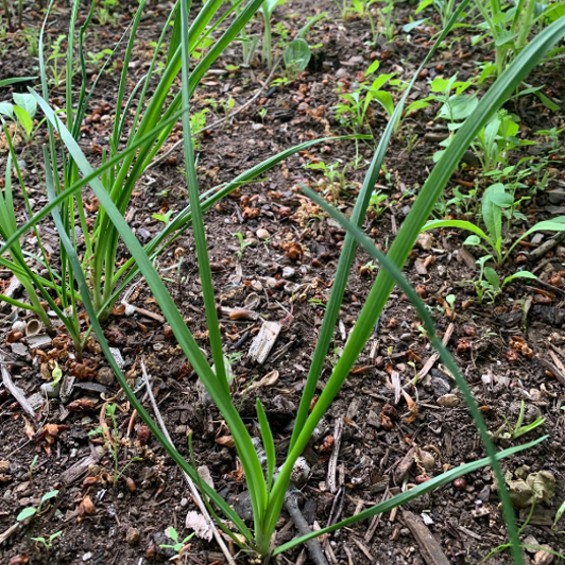
Description: A native perennial bulb in openings in the forest, or rocky outcrops at the edge of dry open woodlands. Resembles cultivated onion or daffodils to some people. There are other cultivated onions in the pollinator garden at the University of Southern Maine, so pay close attention to the fine details.
ID: It has narrow, grass-like leaves that may stand upright or droop on the ground depending on growing conditions. From the center of the leaf bundle, arises an umbrella-shaped cluster of starry white or pink pendant flowers.
Flowering time: Mid summer to early fall.
Wildlife dependents: Bees, including bumble bees, halictid bees, sweat bees and even honeybees.
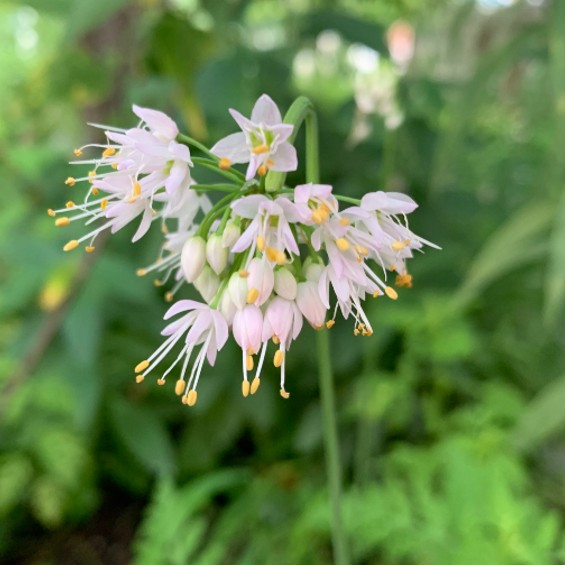
Grow your own: Plant in full sun. It requires well-drained soil with far more sand than clay. In our experience, gardeners can easily mistake the young leaves for grass, so be careful when weeding.
Interesting facts: Nodding onion is deer-resistant because people theorize that they don’t like the taste of it.
Citation: “Allium cernuum.” Lady Bird Johnson Wildflower Center – The University of Texas at Austin.
Common names: Jewelweed, Spotted Touch-me-not
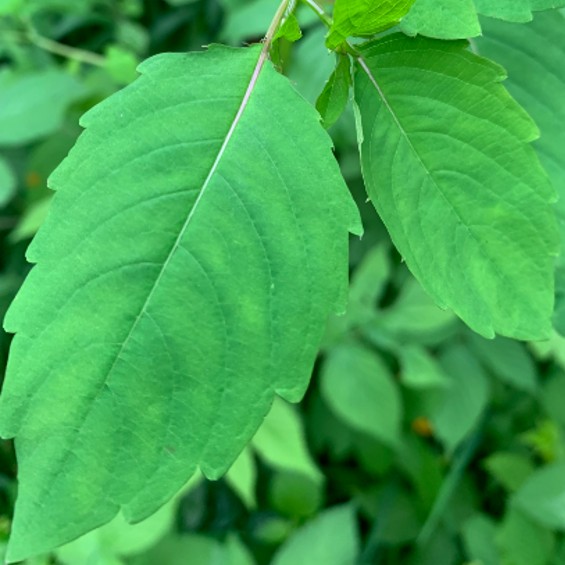
Description: native annual plant of boggy, shady areas. It typically occurs in low woodlands and thickets, along stream banks and next to swamps.
ID: Features 1″ long, rear-spurred, cornucopia-shaped, orange-yellow flowers with reddish-brown spotting. Each flower dangles from a leaf axil on its own slender stalk.
Flowering time: Mid summer to early fall.
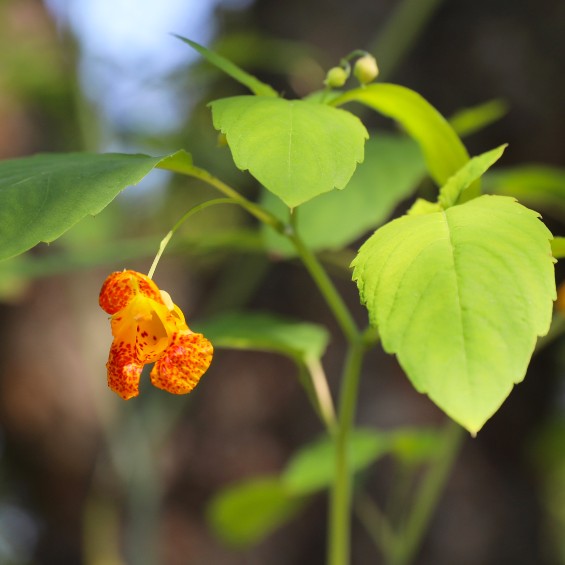
Wildlife dependents: Birds, hummingbirds, and butterflies
Grow your own: Plant in moist soils. In our experience, it can tolerate sun or shade, but does best if provided a least a little bit of shade. It can grow in clay. Although this plant is delicate, it can grow fast and aggressively, so be mindful what you plant it near.
Interesting facts: The seeds pods pop open at a touch providing endless enjoyment for young children.
Citation: “Impatiens capensis”. North Carolina Extension Gardener Plant Toolbox. North Carolina State Extension.
“Impatiens capensis.” Lady Bird Johnson Wildflower Center – The University of Texas at Austin.
Common names: Common Yarrow, Old Man’s Pepper, Devil’s Nettle, Sanguinary, Milfoil, Soldier’s Woundwort, Thousand Seal
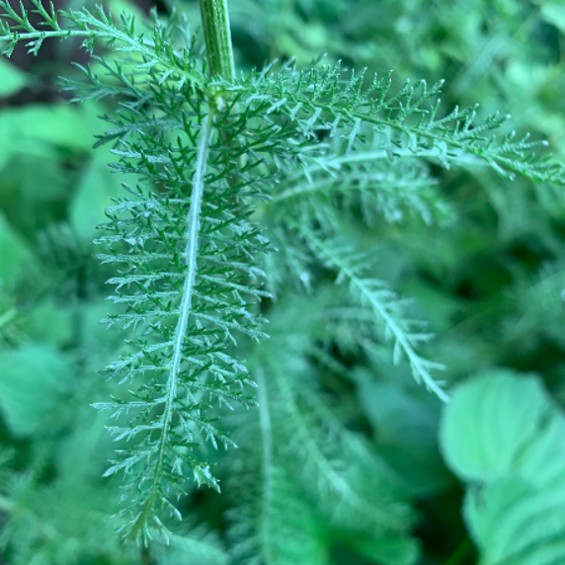
Description: A rhizomatous, spreading, upright to mat-forming perennial that grows in meadows, cliffs or human-disturbed areas, such as lawns.
ID: Noted for producing deeply-dissected, fern-like, aromatic, green foliage. When in bloom, it produces tiny white flowers that appear in dense, flattened, compound corymbs (to 2-4” across) throughout the summer.
Flowering time: June to September
Wildlife dependents: Butterflies and bees
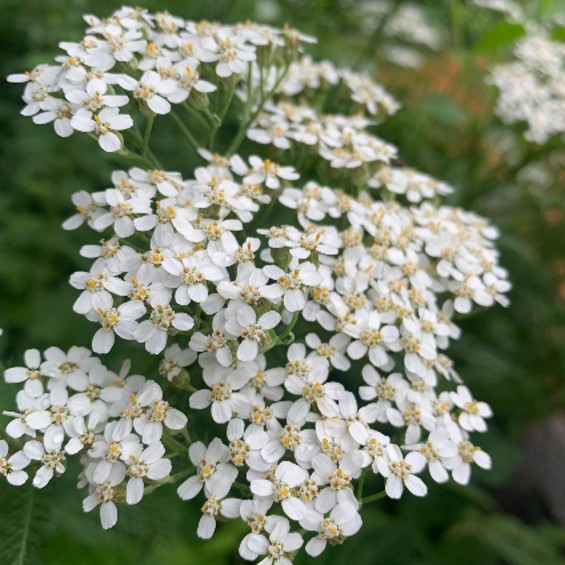
Grow your own: Plant in full sun in dry to medium soil. Yarrow can successfully grow in less than ideal conditions once it gets established. Wherever dandelion can grow, yarrow usually can too in our experience.
Interesting facts: Its latin species name “millefolium” means “a thousand leaves,” likely a reference to how its deeply cleft leaves make it appear like each stem is covered in countless mini-leaves.
Citation: “Achillea millefolium.” Lady Bird Johnson Wildflower Center – The University of Texas at Austin.
“Achillea millefolium.” Go Botany. Native Plant Trust.
“Plant of the Week: Common Yarrow.” U.S. Forest Service. United States Department of Agriculture.
Anise Hyssop, Giant Hyssop, Lavender Hyssop
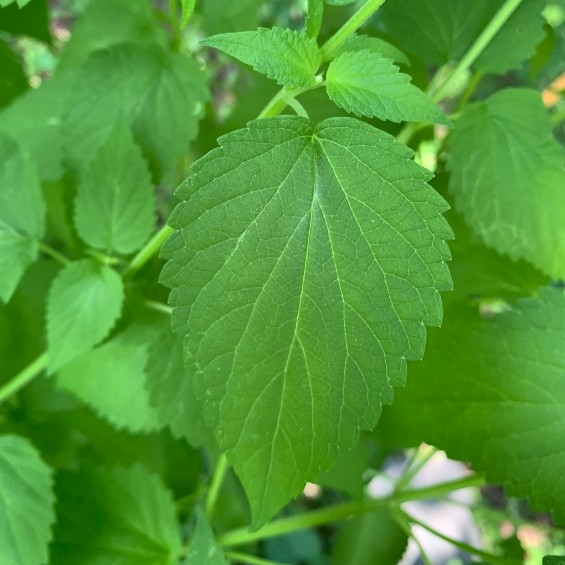
Description: A tall native perennial that smells like black licorice.
ID: An upright plant growing 2-4 feet tall. The leaves appear opposite on the stem and are prominently serrated on their edges. The purple flowers grow in long spikes at the top of the plant.
Flowering time: Late summer to mid fall.
Wildlife dependents: Bees, such as small resin bees. Butterflies, such as the Great Spangled Fritillary. Birds, such as hummingbirds.
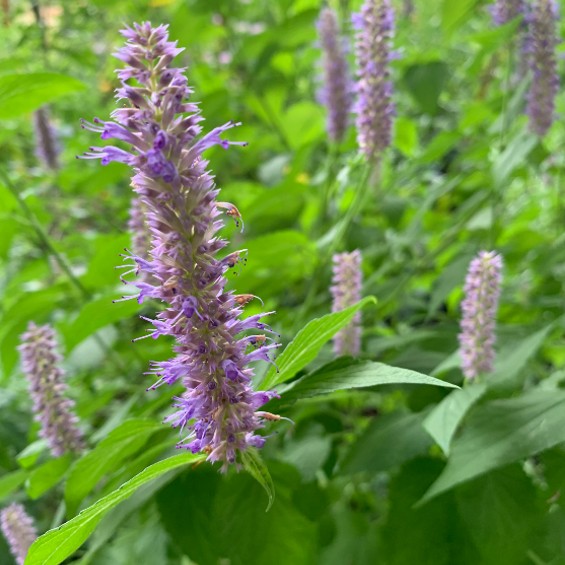
Grow your own: Plant in moist, but well-drained soils. Will tolerate a range of sunlight amounts.
Interesting facts: Anise hyssop is in the mint family, and has the typical square stem found in the mints.
Citations: “Agastache foeniculum.” Lady Bird Johnson Wildflower Center – The University of Texas at Austin.
“Agastache foeniculum.” North Carolina Extension Gardener Plant Toolbox. North Carolina State Extension.
“Fragrant (Anise) Hyssop- Agastache foeniculum.” Pollinators of Native Plants. By Heather Holm. 2014. Pollination Press, LLC. Minnetonka, MN.
Common names: Jerusalem artichoke, Sunchoke, Sun Root
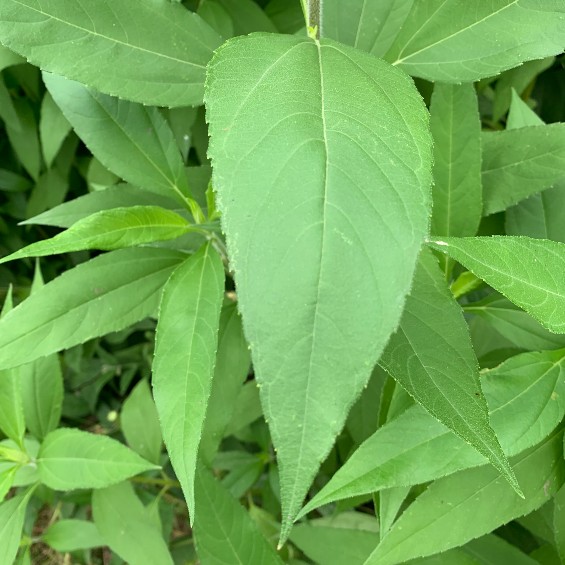
Description: A native member of the sunflower group. It may be found in fields, on the edges of yards, and along rivers or roads.
ID: The stems are strong and hairy. The leaves are fairly large and serrated. The yellow flower heads are approximately three inches wide and strongly resemble other sunflower relatives.
Flowering time: August to September
Wildlife dependents: Mammals, such as deer, as well as birds, bees and butterflies
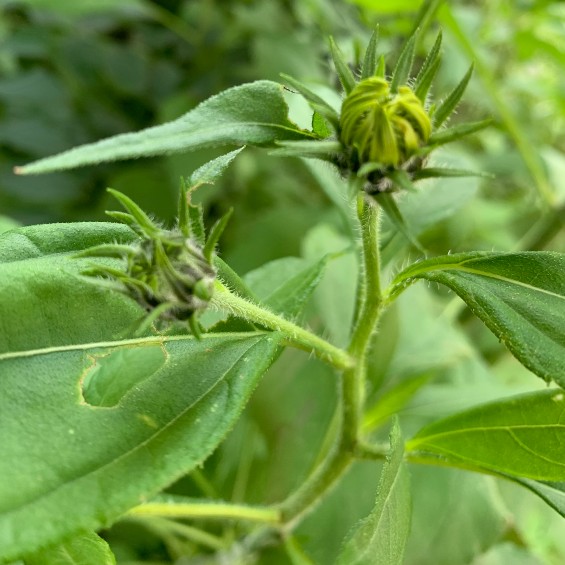
Grow your own: Planting in sunny areas that have fairly dry soils. Jerusalem artichoke can grow fast and strong, so be careful what you plant it near. This is certainly true in our experience, but fears of it taking over already established plantings of similar heights may be overblown as we have seen it held at bay in such a scenario.
Interesting facts: Can reach 10 feet in height.
Citation: “Helianthus tuberosus.” Lady Bird Johnson Wildflower Center – The University of Texas at Austin.
“Jerusalem Artichoke (Sunflower Artichoke).” Missouri Department of Conservation.
Sound
Common name: Elderberry, American Elder, Black Elder, Sweet Elder, Wild Elder, Tree of Music
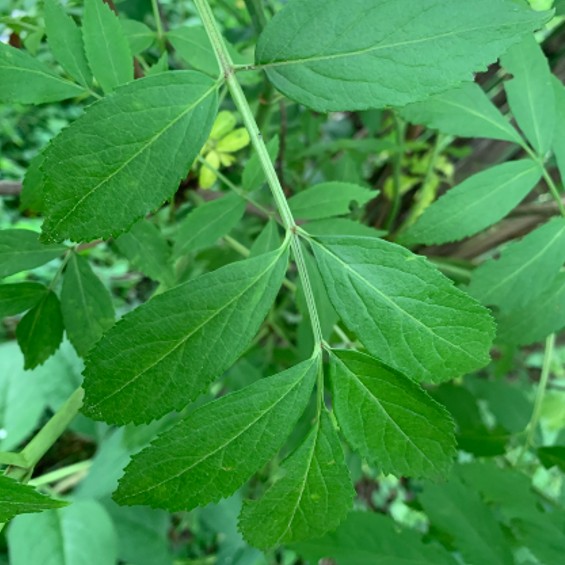
Description: Fast growing, deciduous shrub with both woody and herbaceous branches. Some members of this genus are native, while others are not.
ID: This shrub may grow to 12 feet tall, and features many long stems arising from the base, arching as they go. The stems are covered in very large lenticels that look like warts. The stems and branches are light-weight as they are filled with white pith. The leaves are pinnately-compound, and usually up to 12 inches long.
Flowering time: May to June
Wildlife dependents: Bears, deer, moose, birds, and the smaller pollinators like butterflies.
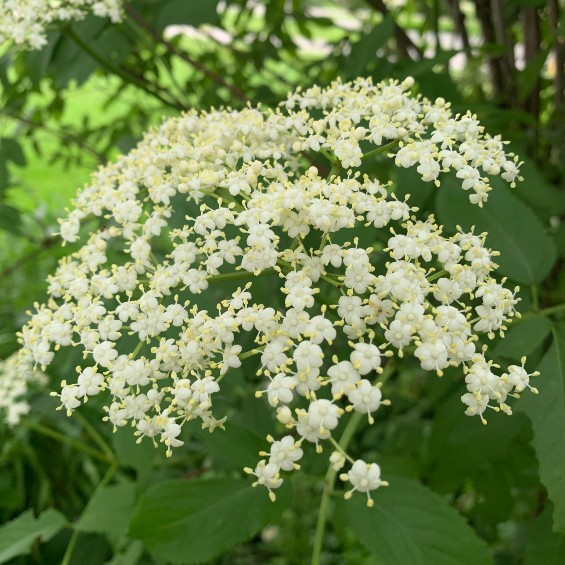
Grow your own: Plant in full sun if possible. They will grow in shady conditions, but may not grow very big or flower. They need regular water, and can actually tolerate being close to standing water. We have seen success planting them in clay soil.
Interesting facts: The unripe fruits, leaves, and stems are rich in cyanogenic glycosides. This compound, when metabolized, is converted into cyanide.
Citations: “Attempted Quantification of the Cyanogenic Glycosides Prunasin and Sambunigrin in the Sambucus L. (Elderberry).” by Elizabeth Grant. (2016). Honors College: 389. University of Maine Digital Commons.
“Sambucus canadensis.” North Carolina Extension Gardener Plant Toolbox. North Carolina State Extension.
“Sambucus nigra ssp. canadensis” Lady Bird Johnson Wildflower Center – The University of Texas at Austin.
Common name: Echinacea, Purple Coneflower, Pale Purple Coneflower
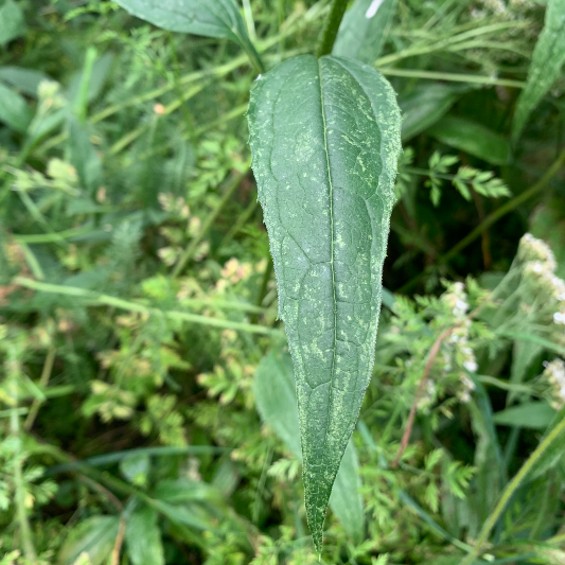
Description: A popular native perennial with smooth 2 – 4 foot stems and long lasting purple flowers.
ID: Rough, scattered leaves that become small toward the top of the stem. Flowers occur singly atop the stems and have domed, purplish-brown, spiny centers and drooping, lavender rays.
Flowering time: Summer to early fall.
Wildlife dependents: Hummingbirds, honeybees, native bees, bumblebees, beetles, and butterflies, such as tiger swallowtails and American ladies.
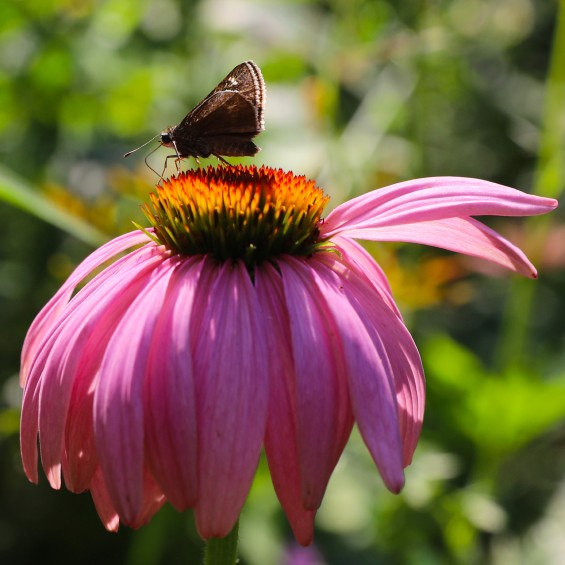
Grow your own: Plant in full sun with well draining soils.
Interesting facts: This plant is a magnet for pollinators.
Citations: “Echinacea purpurea.” Lady Bird Johnson Wildflower Center – The University of Texas at Austin.
“Echinacea purpurea.” Pollinators of Native Plants. By Heather Holm. 2014. Pollination Press, LLC. Minnetonka, MN.
Common name: Kentucky Coffeetree
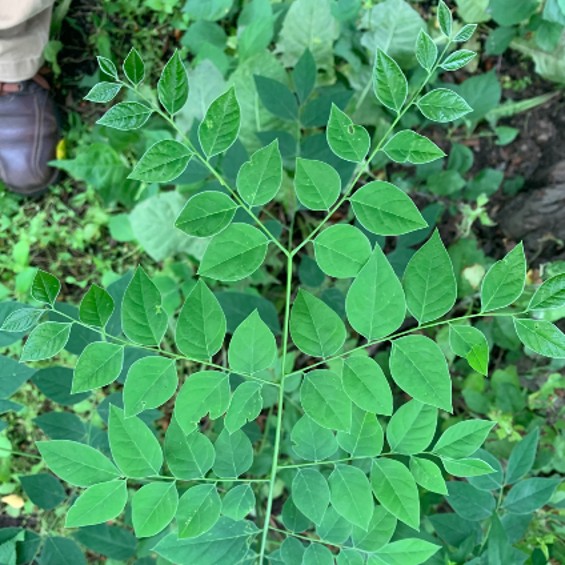
Description: A tall deciduous tree, native to the midwest and parts of the south, but not the northeast.
ID: It grows 60 – 80 feet tall. The gray-brown bark is rough and scaly. Large, bipinnate-compound leaves spread from the branches. It produces long pods filled with sticky green material and bean-like seeds.
Flowering time: May – June
Wildlife dependents: Bumblebees, long-horned bees, butterflies and moths.
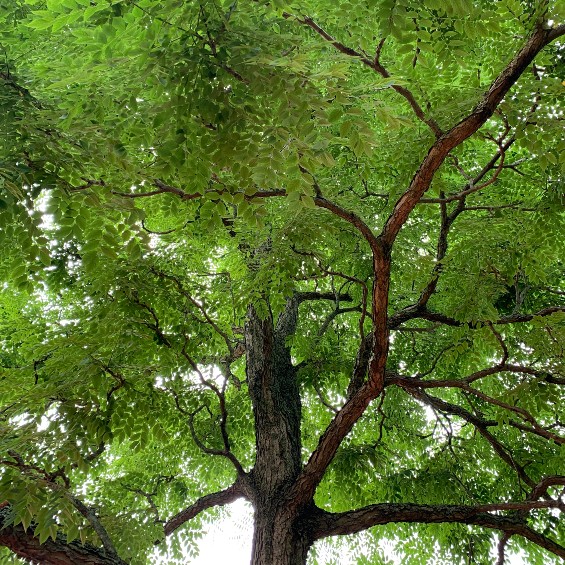
Grow your own: Full to partial sun
Interesting facts: Its wood was once used to build railway sleeper cars. It has the largest leaves of any native tree in Canada.
Citation: “Gymnocladus dioicus.” Lady Bird Johnson Wildflower Center – The University of Texas at Austin.
“Kentucky Coffeetree.” Arbor Day Foundation.
Common names: White Wood Aster, White heart-leaved Aster, Wood Aster
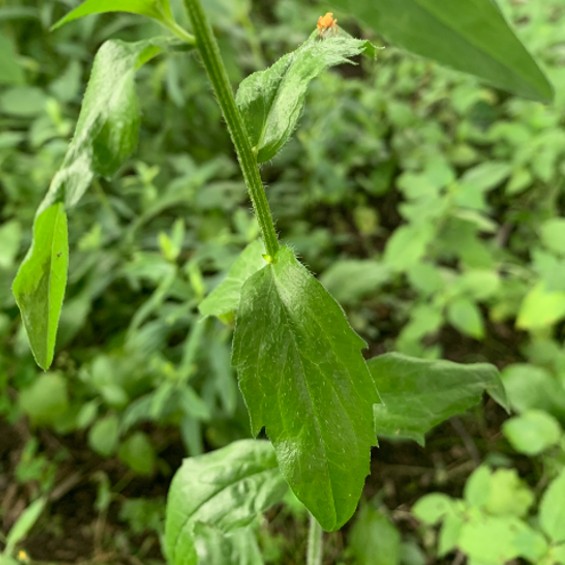
Description: A native-to-Maine plant that grows in the woods and on the edges of fields.
ID: A hairy plant with yellow and white flowers. The leaves are serrated, and the stems sometimes take on a zigzag pattern. The whole plant can grow up to 2.5 feet tall.
Flowering time: Late summer through fall
Wildlife dependents: Bees and butterflies
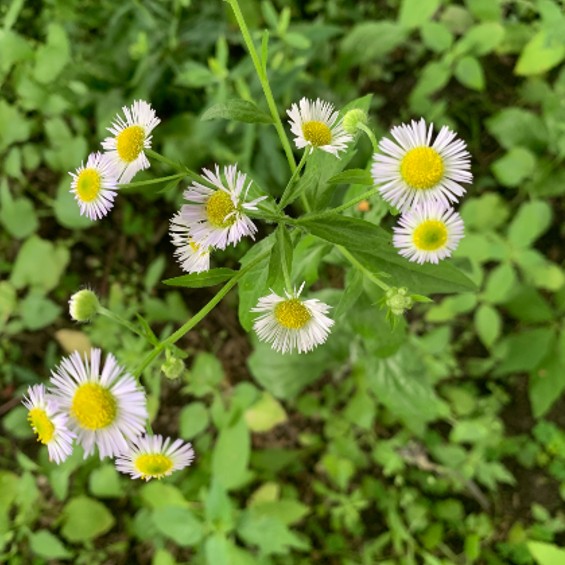
Grow your own: Plant in well-drained, dry soil in an area with at least some shade.
Interesting facts: There are numerous species of plants that people refer to as “asters” that have similar-looking flowers, comprised of discs and rays. Additionally, the “astor” family (Asteraceae) is a large grouping of a range of genera. The lack of specificity in the word “aster,” speaks to the limitations of using commons names.
Citations: “Eurybia divaricata.” Go Botany. Native Plant Trust.
“Eurybia divaricata.” Missouri Botanical Garden.
“Eurybia divaricata ” Lady Bird Johnson Wildflower Center – The University of Texas at Austin.
Common names: Calico Aster, Starved Aster, and White Woodland Aster
Description: A Maine native perennial that can be found in fields and on the edges of forests.
ID: This herbaceous plant with narrow, serrated leaves can grow 2-3 feet tall. It sports small white ray flowers, surrounding yellow or purple disc flowers. It is common to find both yellow and purple disc flowers on the same plant. Each flower head has a handful of rays and a handful of tubular disk flowers.
Flowering time: late summer through mid fall
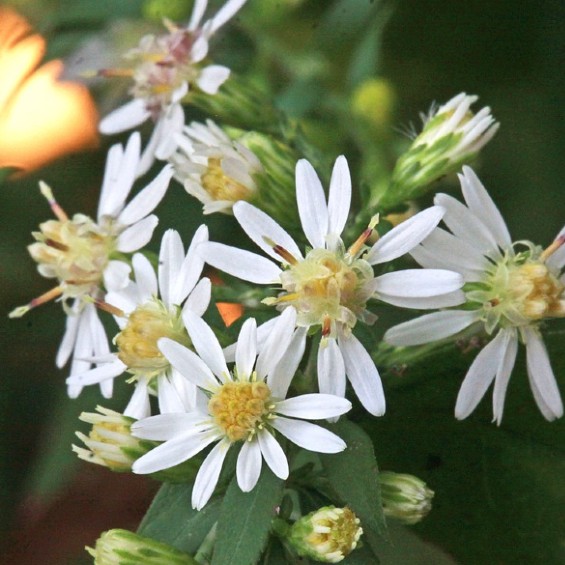
Wildlife dependents: Bees and butterflies
Grow your own: Plant in light shade or partial sun, in fairly dry soil for the best outcome. If the plant has all its other needs met, it may tolerate full sun. In our experience, it has tolerated a range of sunlight conditions.
Interesting facts: In Greek, Aster means “Star.”
Citations: “Symphotrichum lateriflorum.” Go Botany. Native Plant Trust.
“Symphotrichum lateriflorum.” Lady Bird Johnson Wildflower Center – The University of Texas at Austin.
Common names: Fleabane, Aspen Fleabane, Garden Fleabane, Showy Fleabane
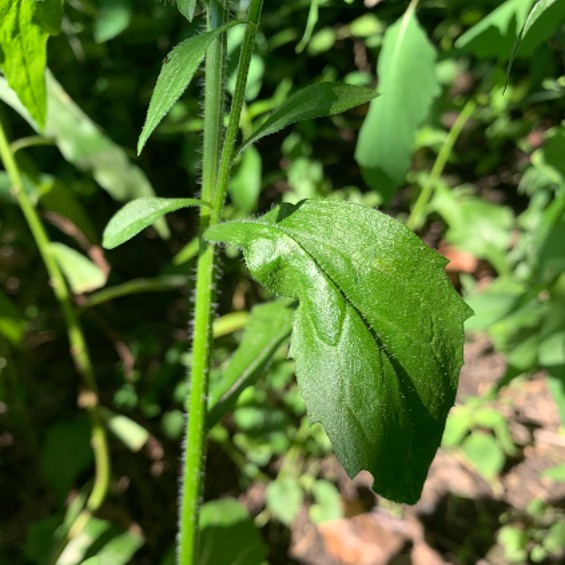
Description: A common, native, herbaceous plant that is found in fields, along power lines and other areas where humans have left openings in the land.
ID: A hairy-stemmed plant with irregularly serrated leaves. Its flowers are white and yellow, reminiscent of daisies.
Flowering time: Summer through fall
Wildlife dependents: Woodland mammals, such as deer and mice. Bees, such as masked bees. Wasps, such as Sphecid wasps, and flies, such as Bottle flies.
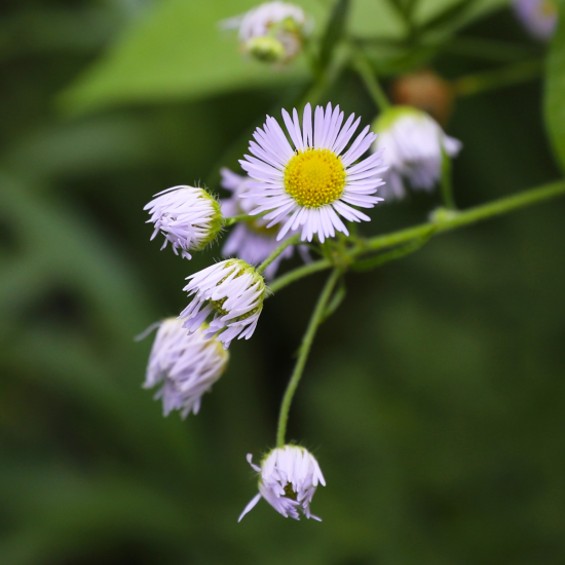
Grow your own: Plant in full sun or partial shade, ensuring that the soil is well-drained.
Interesting facts: Some of the fleabanes native to the northeastern United States are becoming invasive in Europe, which is the mirror of what we experience in the U.S. when Europeans species are imported here.
Citations: “Annual Fleabane (Erigeron annuus).” bplant.org.
“Erigeron.” Lady Bird Johnson Wildflower Center – The University of Texas at Austin.
“Weed of the Month: Fleabane.” Plants & Garden Blog by Saara Nafici. Brooklyn Botanic Garden.
Common name: Devil’s Beggarticks, Tickseed, Beggarsticks, Devil’s Pitchfork, Pitchfork Weed
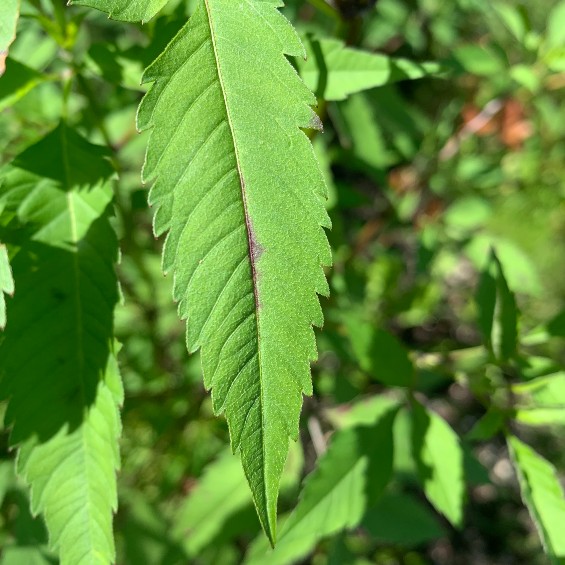
Description: A native-to-Maine perennial.
ID: This medium-sized plant with sparse, compound leaves, with strongly serrated edges, is reminiscent of water hemlock. But, unlike water hemlock, it features small yellow flowers. Additionally, the leaf veins end at the tips of the serrations, not between the serrations, like they do in water hemlock.
Flowering time: Late summer through early fall
Wildlife dependents: Mammals and native bees
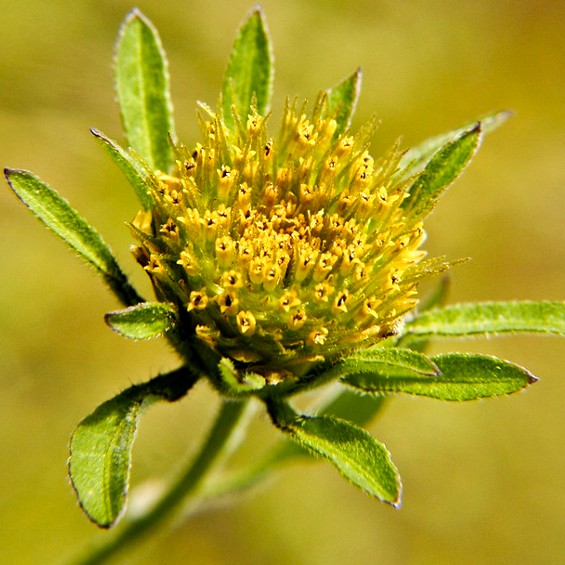
Grow your own: Plant in partial to full sun in medium moisture soil.
Interesting facts: An invasive species in New Zealand.
Citations: “Beggars Tick.” Environment. Bay of Plenty Regional Council. Toi Moana.
“Bidens frondosa.” Go Botany. Native Plant Trust.
“Bidens frondosa L.” Plants. United States Department of Agriculture.
“Bidens frondosa.” Lady Bird Johnson Wildflower Center – The University of Texas at Austin.


